
PLUS YOUR COMPANION FOR LIFE IN THE FRENCH COMMUNITY JUNE 2024 I’M FREE - TAKE ME, KEEP ME! ISSUE 214 HEALTH GARDENING ASTRONOMY and much more… Health & Happiness etcetera Of Our Furry Friends Saving Money and Reducing Household Costs Expert Advice 100s of local advertisers INSIDE RECIPES • PUZZLES • HISTORY • WHAT’S ON • OPINION











































Postal Subscriber
Annual subscription France/EU only 55€
Advertise

Commercial adverts: Please see our Media Pack at www.etceteraonline.org
What’s On/Listings: 12€ per 50 words for a guaranteed spot or free (space permitting)
Classified listing: 6€ per 25 words plus 3€ per photo
Property listing: 10€ per 50 words plus 6€ per photo
Code APE 5814Z Edition de Revues et Periodique Siret 80903463000016. La Présidente G. Feasey Registered. Le Bourg, 87360 Verneuil Moustiers.
Impression: Rotimpres. Pol. Ind Casa Nova. Carrer Pla de l’Estany s/n. 17181 Aiguaviva (Girona) Espagne. etcetera est gratuit.
While we always do our best to ensure the content in this magazine is given in good faith and businesses are reputable, we accept no liability for any errors or omissions and do not endorse any companies, products or services. Articles written are the personal opinions of the original authors and do not necessarily reflect the views of etcetera magazine.
A Note from the Editors



CONTACT US:
Tel: 05 17 36 15 32
email: editors.etcetera@gmail.com website: www.etceteraonline.org 17 rue des Chaumettes 86290 St Léomer
etcetera magazine @etceterafrance
Welcome to the June edition of etcetera magazine.
At last, summer has arrived. We can put our waders away (hopefully) and look forward to the next water shortage!
Come rain or shine, we’re happy to bring you another edition packed with articles, advice and hundreds of advertisers.
Wishing you all a fantastic month ahead, and thank you for your support.

15 SAMU (Medical)
17 Gendarmes (Police)
18 Pompiers (Fire and also trained in medical emergency)
112 European emergency not always English 114 Text-message emergency number for deaf/hard of hearing
119 Child abuse
115 Homeless
113 Drugs and alcohol 1616 Emergency- Sea & Lake 3131 Last incoming call, key ‘5’ to connect Orange English speaking helpline 0033 (0)9 69 36 39 00
Website in English: www.orange.com/en/home Technical assistance for landlines (French): 3900 (+33 9 69 39 39 00 from abroad)
SFR 1023 or 00336 1000 1023 (Not English) EDF 8am to 8pm, Monday to Saturday. +33 (0)9 69 36 63 83 EDF Helpline in English 0033 562164908 (From UK)
E-mail: simpleenergywithedf@edf.fr
CPAM - 09 74 75 36 46
Veolia Water Emergency No: 24h/24 et 7j/7
05 61 80 09 02 (press 1 for urgent problems or 2 for a technician)
S.E.P Du Confolens (Water)
05 87 23 10 08 Emergency 24/7
Aéroport Int’l Limoges 05 55 43 30 30
SNCF (train times, buying tickets etc) 36 35
Credit Agricole English Speaking Helpline
Charente (residents only) 05 45 20 49 60
Alcoholics Anonymous
For contact details of meetings in your area including those conducted in English, visit www.aafrance.net

SSAFA France 05 53 24 92 38 email france@ssafa.org.uk
Please download
HOSPITALS
05 55 05 55 55 Limoges (CHU)
05 55 43 50 00 St Junien
05 55 47 20 20 Bellac
05 49 44 44 44 Poitiers
05 45 24 40 40 Angoulême
05 49 32 79 79 Niort
05 45 84 40 00 Confolens
Bereavement Support Network
English speaking support group for guidance on coping with bereavement in France. Personal and practical advice. www.bsnvar.org
Women for Women in France offering support to foreign-born (non-French speaking) women dealing with domestic abuse www.womenforwomenfrance.org
Counselling In France Counsellors, psychotherapists, NLP, CBT etc offering therapy in English to expatriates all over France on www.counsellinginfrance.com
French Health Insurance Advice line
CPAM English speaking Advice line: 09 74 75 36 46 (from France) 0033 974 75 36 46 (from other countries). The line is open from Monday to Friday, from 8:30 a.m. to 5:30 p.m.
NHS website : www.nhs.uk/using-thenhs/healthcare-abroad www.ameli.fr
No Panic France Helpline: No Panic UK helpline: 0044 1 952 590 545 11h - 23h (French time) 7/7 www.nopanic.org.uk /nopanicfrance@orange.fr English-speaking Mental Health Line
SOS- HELP 01 46 21 46 46 3pm-11pm 7/7
British Consulate in Paris 01 44 51 31 00
British Consulate in Bordeaux 05 57 22 21 10 www.ukinfrance.fco.gov.uk/en/
3 A note from the editors 4 What’s on 8 Craft 10 History 14 Language 17 Opinion 18 Food 23 Business 29 Health 34 Garden 40 Free time 42 Astronomy 44 Animal 47 Nature 50 Home & specialist 52 Getting connected 55 Artisans 62 Motoring & removals 64 Property 66 Classified Contents
Photo credits: Bigstock, Pixabay, Shutterstock, Dreamstime
Useful numbers
Card payment
telephone
by
Gayle and Sam
the
from this link now: www.paysruffecois.fr/sante/guide.pdf Print 2 copies - one for your home and one for your car - it could save a life. NO international code needed from UK mobiles hello & welcome
pdf
etcetera 3
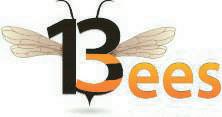

















4 etcetera listing




















etcetera 5 listing



listing ‘ 6 etcetera


La Vieille Ecole Brocante & Tearooms
Set in the rolling hills of the Haute Charente, based in a former school you will find La Vieille Ecole Brocante. Alongside the wide selection of vintage French furniture, you will also find Autentico chalk and lime paints and an English tearoom.
Jo Booth and her husband Tony moved to France in 2018, starting their business a year later. The brocante grew in size when they moved to the former school in 2021. In 2023 the couple extended the business to include Autentico paint and the tearoom. The couple welcome regular and new customers each week. They will help you
They will help you find the right piece of furniture, or source pieces if not already in the showroom
find the right piece of furniture, or source pieces if not already in the showroom. They are on hand to offer advice for your paint project; be that a piece of furniture to update or interior/exterior of your home. Not forgetting the tearoom where you can choose from a selection of handmade cakes, sandwiches and Afternoon Tea in the summer months.
If you are yet to visit, then take a ride over. Browse the brocante, learn about the extensive range of paint and decorative products Autentico have to offer, then enjoy refreshments while enjoying the view of the Lac du Mas Chaban.
















etcetera 7 EASTMIDLANDS
Advertorial
Impasse
16310 Lesignac-Durand Open Friday and Saturday 10h-16 T: 06.02.19.73.11 E: lavieilleecole@outlook.com www.lavieilleecolebrocante.com
La Vieille Ecole Brocante & Salon de Thé
du Mas Chaban
Siret number 843047853 Furniture and decorative items, turning your house into a home

Sheet Music Wreath Tutorial
THIS CRAFT IS EASY TO MAKE AND THE RESULT IS A STUNNING DECORATIVE WREATH FIT FOR ANY ROOM!
You can make this wreath any size, make it bigger by using three rows of music sheet cones or smaller by cutting the sheet music smaller
Materials
50-60 pages sheet music, vintage, copies, or new
1 piece cardboard, desired size
1 meter ribbon, twine, or wool, (or desired length)
Pair of scissors
Glue gun and glue sticks
1. Cutting the sheets - Larger cones: Cut the music sheets into squares to roll even cones. Mark the longer edge at the same spot of the width of the paper and
cut across (so you’re making a square of your desired size).
2. Smaller cones: Cut the paper into smaller squares for the smaller cones, though you should cut one and see how you like it, adjusting the size square as you'd like.
3. Cut the cardboard - Determine the size you want for your base and use a large plate (or protractor) to draw a circle on the cardboard for the wreath base. Cut around the line. Notes - The cones will hang over the cardboard base so you don't need to make the base as large as your finished wreath.
4. Draw the inner circle using a small bowl - again, the size will depend on your chosen sheet size you’re using.


Cut along this circle and for your wreath base. You’ll be left with a doughnut shape of cardboard.
5. Create the music sheet rolls - Roll the larger squares into cones. Make sure there is a point at the largest open end and that it has the best part of the sheet (be sure it's not blank, but that there is music showing) and make the smaller end as tight as you can.
6. Unroll a bit of the bottom of the cone and use hot glue to glue them closed so they won't unroll. (You may need an added a piece of tape if the hot glue needs time to dry.)
7. Attach cones to the base - Once the cone is glued closed, use more hot glue to attach it to the cardboard base. Make sure both ends of these larger cones hang over the base on each sideyou don't want any of the base showing.
8. Glue your first cone to the base and then use it as a guide for placing the cones next to it and then all around the base, making one cone at a time (making one at a time lets you roll the cone bigger or smaller as needed to fit them evenly around the base).
9. After the first row is complete, use the same method to attach the smaller cones of the second row to the first row. Again making them one at a time and placing where they look best to make the inner row.

10.Attach hanging ribbon - Use ribbon, twine, or yard to make a holder for the wreath by one of two methods: 1) For wider ribbons like my wreath, you can simply staple the ribbon ends to the cardboard base. 2) For thinner ribbon or twine, you can make a hole in the cardboard and thread it through to create a holder.
craft 8 etcetera Steps

























craft etcetera 9 EI BESPOKE JEWELLERY, REMODELLING, REPAIRS, PEARL STRINGING Browse our selection of unique gifts, enjoy a meal from our new menuindoor & terrace seating available. BESPOKE by Denise can also be contacted directly on 06 75 89 95 55 To view our collection, please visit our FB page: www.facebook.com/bespokedenise.eyre or website www.bespokebydenise.com Open Tue-Sat DENISE EYRE (EI) AT THE LEMON TREE CAFÉ 71 Grand Rue 79190 Sauzé Vaussais 05 49 07 78 22 T i Siret: 89235834200020 John Selley EI - 09 77 00 66 38 Email: encadrement.oradour@gmail.com Encadrement d’Art 1 Rue du 19 Mars 1962 87150 Oradour sur Vayres Custom Framing for Arts, Crafts & Memorabilia Picture framers to La Galerie de Gabriel etcetera magazine - Your Companion for Life in the French Community Workshops from 35€ Siret 91843535500014 Art & Tuition Visit My Barn Gallery Individual / Joint Art Lessons Together we will work on your projects, with my experienced guidance and support Contact Petra 06 08 11 70 41 Open Tue-Sat petra.lober@t-online.de 87310 Saint Auvent www.pkl-unknown-and-strange.de From just 39€ ttc per month editors.etcetera@gmail.com I’m Free But I Could Be Yours…. Contact Andrea: 06 17 45 65 60
18 Rue de la Republique
La Trimouille Come and learn hand building pottery techniques and create your own ceramic treasures at my pottery studio. 3 hour workshops 25€ per person Siret 49064489500032 Christie’s EI GORGEOUS GIFTS GALORE 1000s of BEAUTIFUL CARDS DELICIOUS HOME-MADE CAKES Home-Made Lemonade & Iced Tea Artisan Ice Lollies & Sorbets
05.49.50.61.94
behind
closedSundays&Mondays
ateliernumero18@gmail.com
86290
www.chezchristies.fr
GENCAY(86)
Mairie
Cartwheel Coins
ONE OF THE ODDEST COINS EVER MINTED IN BRITAIN WAS HUGE. HERE IS ITS STORY

Coins have been around for centuries. The first were issued in the ancient realm of Lydia, in the Middle East, in about 600 BC. These had been little more than lumps of a natural gold-silver alloy called Electrum, stamped with a design of a bull’s head to make them recognisable as coins. The first pure gold coins were issued about 50 years later, under the legendary Lydian king Croesus.
Gold has continued to be used to strike high-value coins ever since – Britain still issues sovereigns to this day. However, as inflation has weakened currencies, there has been a need for coins of lower value.
What Metals Are Acceptable for Coins?
Originally, silver was used. This, of course, had a much lower intrinsic value than gold, so smaller denominations could be minted. It was always the aim that the intrinsic value of each coin should reflect its purchasing power, i.e. a silver coin of value one shilling would contain a shilling’s worth of silver. This seems selfevident, and can work as long as metal prices don’t fluctuate too much. However, as prices of precious metals rise, the value of a coin can become something much higher than its face value. Don’t forget, a currently-minted gold sovereign can be purchased from the Royal Mint (May
2024) for roughly £460 (540 €) – well above its face value of £1!
This is why gold coinage, while legal tender, is no longer used as such. It is a way of hoarding readily-negotiable bullion, or for wealthy coin collectors, but everyone has to agree on the value of each coin. In historical coins there are also rarity considerations.
Thus, for the last two millennia, silver has been the currency metal of choice for everyday transactions. It was malleable, like gold, which meant it could be struck with a design. The amount of metal could be varied more easily, and the size of the appropriate quantity of silver was more manageable. The Greeks, the Celts, the Romans, all dealt in silver coins. Few of us alive today have, though, as the last British pure silver coin for normal monetary circulation was minted in 1920, when bullion prices became unstable. For a few years (until 1946) an alloy of 50% silver was used, but then Cupro-Nickel took over and became the “silver” coinage. In 1971, decimalisation put paid to any “old” silver that was still circulating, so if you are under 50 years old it is unlikely that you

 ByMikeGeorge
ByMikeGeorge
Mike George is our regular contributor on wildlife and the countryside in France. He is a geologist and naturalist, living in the Jurassic area of the Charente
will have paid for anything with a silver coin.
Meanwhile, there was another coinage metal available which had the malleability to be struck, and this was copper (or certain of its alloys). This was a lot lower in value, but a penny’s worth could be roughly coin-sized.
“Striking” a Coin
It didn’t always have to be an accurate portrait of the king – nobody apart from nobles knew what he looked like anyway
A word should be said about coin-striking at this point. The whole point of striking coins was to show those passing the coin (1) that this was a coin and (2) who had issued it, usually the king. It didn’t always have to be an accurate portrait of the king –nobody apart from nobles knew what he looked like anywaybut his name was usually written on the coin as well. Designs on the coin were increasingly complex to discourage forgery and large enough to cover the whole area of the coin to prevent “clipping” or the removal of tiny shavings of precious metal for re-use elsewhere (not usually a problem with copper!).
Some coins were cast, but this was a timeconsuming and wasteful process. The



history 10 etcetera
A hammered silver sixpence of Elizabeth1. Obverse and reverse
A hammered silver two-penny piece of Edward lll Obverse and reverse



method of choice was to have an engraver cut the designs for the two faces of the coin into hard metal dies and then place between them a suitably-sized disc of the coin-metal and give the whole thing a sharp clout with a largish hammer. That is why this type of money is usually described as “hammered” coinage. Of course, you enclosed the whole thing in a collar and put a punch-anvil on the upper die, thus stopping the precious metal disc from flying all over the workshop after you had struck it. Usually, if you were good at this, you ended up with a useable coin. However, the system had its limitations. The strike was always uneven in pressure over the disc, and the two faces were randomly oriented. Eventually the screw-press was invented, which could cure these faults, but this slowed the process down considerably, and hand-striking was preferred.
This system produced a far crisper strike, and the obverse and reverse could be oriented to each other
It wasn’t until the end of the 18th century that steam power became linked to coinstriking. This happened at about the same time as it became possible to supply standard-sized discs of metal in quantity. The first people to produce a steam-driven coining machine were James Watt (of course) and his business associate Matthew Boulton. They installed the first one at their Soho workshops in Birmingham in the late 1790s.
This system produced a far crisper strike, and the obverse and reverse could be oriented to each other. Furthermore, it could handle discs of any size (within reason) and operated a lot faster than any of the previous systems. You could even arrange for a pattern or a statement to be impressed on the periphery of the disc (that’s how milled coinage began). On many of the large silver coins of the 18th

Post-medieval hoard of coin clippings
and 19th century you will find the regnal year of the monarch or a motto such as “Decus et tutamen” (“A decoration and a safeguard”) stamped into the edge of the metal disc to discourage clipping.
Copper coinage had been produced for reigns before George III, but now there became a shortage of such lowdenomination coins, and a lot of companies and organisations began to strike their own “tokens”, usually for local



history etcetera 11
A very poor counterfeit copper halfpenny of the early 1770s. It would not have fooled a blind man, but was useful for day-to-day transactions while real coins were scarce
A cast silver stater from Southern England. Date between 50 and 10 BC
Clockwise: Anvil die and hammer die used to make English silver pennies dating from the 14th century, 17th century coin-clipping shears


circulation, to relieve the problem. Note, these were never referred to as coins, didn’t even look like coins, and thus currency forgery could not be alleged. However, things were starting to get out of hand. Criminal groups were beginning to produce forgeries of currency coins and passing them off as genuine. They were often a pretty poor apology for the genuine coins, but with the admitted lack of available low-denomination coins and the consequent need for value to pass from hand to hand, the Government’s options were low. A complete currency re-think was needed.
Enter the Cartwheel Coins
In 1797, the government authorised Matthew Boulton to strike copper pennies and twopences at his Soho Mint, in Birmingham, on his lovely new steampress. The law still at that time was that the face value of a coin should
correspond to the value of the material it was made from, so each twopence coin was made from twopence’s worth of copper (2 ounces), and a penny from one ounce. This requirement means that the coins were many times larger than the silver pennies minted previously. The large size of the coins, combined with the thick rim where the inscription was punched into the metal, led to the coins being nicknamed "cartwheels". All "cartwheel" twopences are marked with the date 1797. In total, around 720,000 twopences were minted.
The large size of the coins, combined with the thick rim where the inscription was punched into the metal, led to the coins being nicknamed "cartwheels"
The twopence was minted in copper, with a weight of 2 oz (56.7 g) and a diameter of 1.6 in (41 mm). The obverse features a right-facing portrait of George III, and

incused (sunk into, not in relief) on the surface of the wide rim are the words GEORGIUS III·D·G·REX. The initial K appears on the lowest fold of the drapery at the base of the effigy, indicating that the design is the work of the German engraver Conrad Heinrich Kuchler. The reverse shows the left-facing seated figure of Britannia, with a trident held loosely in her left hand, and an olive branch in her outstretched right. There are waves about her feet, with a small ship to the left and a Union Jack shield below and to the right. Above, on the rim, is incused the word BRITANNIA, and on the rim below the image is incused the date 1797. The reverse was also designed by Kuchler. The word SOHO appears next to the shield, indicating that

history 12 etcetera
The great copper cartwheel two-penny piece of George lll, produced by steam-striking
Left: Matthew Boulton, inventor, mechanical engineer and silversmith. Right: Boulton created the Soho Mint in his Soho manufactory in Birmingham 1788
the coin came from the Soho Mint. Strangely, no attempt seems to have been made to put any motto or decoration onto the lovely wide edge of the coin.
The penny is identical apart from being about 2/3 of the size. No value appears on either coin.
The coins were struck probably over 1797 and 1798, but only ever bear the date 1797. They were not popular. If you handle one you will understand why; they are heavy and a bit unwieldy. The number that still turn up in good condition suggests that most folk kept them in a safe place at home. However, they also had a tendency to get lost. Many folks’ only experience of them is digging up a nondescript disc of copper in their garden or finding it with their expensive metal detector. After a couple of hundred years in the soil and rain, the design is sadly defaced!
The final indignity was that the value of copper began to rise. People realised that their unwieldy coins were worth more as metal than as coins, and a good number were (illegally) melted down for their scrap value. In mid-2024, 2 oz of copper is worth nearly £1 (though a good-condition 1797 twopence is worth a good deal more!)
What happened next?
By about 1810, tokens were on the rise again. The government introduced a complete re-monetarisation program, with bronze replacing copper in smaller coins, and in 1817 issued stringent legislation to outlaw the minting of tokens, which
People realised that their unwieldy coins were worth more as metal than as coins, and a good number were (illegally) melted down
promptly became worthless, which is why there are quite a lot still available in good condition for moderate prices.
Pennies and tuppences were minted in silver for a while, but copper was never used again. Eventually bronze was used for low-value coinage, since by 1860 the requirement for the coin’s intrinsic value to equal its monetary value had been scrapped. Coinage at last began to work as we understand it, each coin’s denomination relying on government agreement, not on face value.
These days of course we find ourselves hearing talk of cashless societies. Financial transactions being conducted digitally, using credit cards, mobile apps, and electronic transfers. This shift could allow convenience, enhanced security and improved financial transparency, while also raising concerns about privacy, accessibility, and technological dependence. However, I have to admit that the prospect of not having any cash terrifies me!

Up until relatively recently, British coinage had nothing much to do with the decimal system that we know now. In fact, quite a lot of folks still alive (including yours truly) spent their childhood and young adulthood learning the threefold system and using it. The pound was the major unit of currency. This was divided into 20 shillings. Each shilling was divided into 12 pennies (or pence, as was the more popular plural form). Thus there were 240 pence in a pound.
This did have several advantages over a decimal system. Mainly because dividing the currency up into lots was easier. You could divide 240 by 2, 3, 4, 5 and most of their multiples (you could divide 100 by 2 and 5 and their multiples only). However, admittedly multiplying by 240 was rather tricky.
Also the symbols needed to be explained. The pound sign was £. This was an ‘L’ differentiated with a crossbar to show it stood for currency. L was short for Librum, or a pound in Latin, which was the old (very old) definition of a pound as being worth that weight of silver. A shilling was ‘s’, which stood for solidus, another Roman coin, while the penny was ‘d’, which represented denarius, yet another Roman coin.
The use of these terms was very variable. A penny coin was no problem, but a two-
penny coin could be referred to as a twopenny, a tuppenny or a tuppence. Threepenny coins were usually thruppence or a thruppenny-bit. The same went for coins of higher value. Some values had their own names. Fourpence was a groat; a shilling was a bob, two shillings (24 pence) was a florin, the next highest was the halfcrown (2 shillings and sixpence or 30 pence) and of course 5 shillings (60 pence) was a crown. Ten shillings was a bank-note (known as a ten-bob note). Then came the pound, also a bank-note, often referred to as a quid.
Through history there were other named coins: the noble (later the angel) (80 pence or 6 shillings and 8 pence), the mark (160 pence or 13 shillings and 4 pence), plus a host of others that leave the mind bewildered, but which have not been used for several centuries. The only others you may hear, mainly from the 19th century, are the sovereign (one pound, coined in gold) and the guinea (one pound and one shilling, also a gold coin).
On February 15th 1971, Britain and Northern Ireland abandoned their old system of pounds, shillings and pence in favour of a new decimal system; the pound and the penny. The pound became the pound, and rarely the quid; the penny became, to everyone’s horror, the pee!
etcetera 13 history history
The Old System of Coins
A steam-engine under construction at the Boulton and Watt Soho Works, Birmingham
Parlez Français
French conversation, vocabulary & traditions
Chez le vétérinaire
Il y a plus d’animaux domestiques que d’habitants en France !
There are more pets than people in France!
En effet, la moitié des foyers héberge un animal domestique. Cela représente 74 millions d’animaux de compagnie en 2022. Les poissons sont les animaux les plus nombreux (29,1 millions).
In fact, half of all households have a pet. This represents 74 million pets in 2022. Fish are the most numerous animals (29.1 million).
insurance, the annual amount of expenses for our pet has risen to an average of 950 Euros in 2022, according to Ifop. Nous aimons nos chiens et nos chats. Nous leur achetons leurs croquettes préférées, des paniers confortables, des accessoires et même pour certains, des vêtements ! Quand ils sont malades, nous les emmenons au cabinet vétérinaire. Cela coûte, mais nos amis de compagnie ne nous le rendent bien : ils nous font des câlins et nous jouons avec eux.
Presque 6 Français sur 10 possèdent un chien ou un chat
Presque 6 Français sur 10 possèdent un chien ou un chat. Depuis la crise sanitaire de la COVID-19, ce chiffre augmente tous les ans.
Almost 6 out of 10 French people own a dog or cat. Since the COVID-19 health crisis, this figure has increased every year.
97% des possesseurs d’animaux domestiques ressentent un attachement profond envers leur animal, allant jusqu’à le considérer comme un membre à part entière de leur famille. Et oui, notre petit chat et notre petit chien sont chéris comme des enfants !
97% of pet owners feel a deep attachment to their pet, going so far as to consider it a full member of their family. And yes, our little cat and dog are cherished like children!
Nos animaux domestiques nous coûtent cher aussi ! Entre l’alimentation (qui a fortement augmentée ces derniers mois…), les frais de vétérinaire, de toilettage ou d’assurance, le montant annuel des dépenses pour son animal de compagnie monte à une moyenne de 950 Euros en 2022, selon l’ifop.
Our pets are expensive too! Between food (which has risen sharply in recent months…), veterinary fees, grooming or
We love our dogs and cats. We buy them their favorite biscuits, comfortable baskets, accessories and for some, even clothes! When they are sick, we take them to the veterinary practice. It’s pricey, but our pet friends give us back lots of cuddles and we play with them.
Mon chat a l’air triste aujourd’hui. Je ne sais pas ce qu’il a. Il reste assis dans un coin et il ne bouge plus. Il ne joue plus et il n’a pas mangé ce matin. Je pense qu’il est malade, donc je vais au Cabinet vétérinaire.
Isa : Bonjour, je viens avec mon chat. Je crois qu’il est malade.
La réceptionniste : Bonjour. Comment s’appelle votre chat ?
Isa : Il s’appelle Lio.
La réceptionniste : Qu’est-ce qu’il a ?
Isa : Je ne sais pas. Il ne joue plus et il reste assis toute la journée. Il n’est pas comme d’habitude.
La réceptionniste : Je vais appeler le vétérinaire. Vous pouvez aller dans la salle d’attente.
(Quelques minutes plus tard.)

Le vétérinaire : Bonjour. Suivez-moi, par ici !
Isa : bonjour. Oui, merci.
Le vétérinaire : Alors, qu’est-ce qu’il a, Lio ?
Isa : Il a l’air triste. Il ne bouge pas. Il ne mange pas. Il ne joue plus.
Le vétérinaire : Quand a-t-il mangé la dernière fois ?
Isa : Hier matin, il a mangé normalement. Hier soir, il n’a presque pas touché à sa Nourriture, et ce matin, il n’a rien mangé.
Le vétérinaire : Est-ce qu’il boit bien ?
Isa : Oui, je l’ai vu boire.
Le vétérinaire : Je vais l’ausculter. … Il n’a pas de fièvre. Ses yeux et ses oreilles vont bien. Tout va bien dans sa gueule. Son cœur est en pleine forme.
Le vétérinaire : Est-ce qu’il est allé dans sa litière ?
Isa : Oui, et c’est normal.
Le vétérinaire : Alors, je vais palper son ventre.
Lio, le chat : Miaou, miaou.
Le vétérinaire : Ah, je crois que le problème vient de son ventre. Il a mal quand je touche là.
Isa : Ne bouge pas, Lio !
Le vétérinaire : Je pense que Lio a une boule de poils dans son ventre. Il n’arrive pas à l’évacuer, ni en vomissant, ni en allant aux toilettes. Je vais prendre une radiographie pour écarter tout autre problème possible. … Viens avec moi, Lio.
Isa : À tout à l’heure !
(Quelques minutes plus tard)
Le vétérinaire : Nous revoilà ! Oui, rien de grave. Lio a une grosse boule de poils dans ses intestins. Je vais lui donner une crème à avaler, c’est de la paraffine. Cela l’aidera. Il faudra lui donner cette crème avant chaque repas pendant dix jours. Aussi, je
14 etcetera language/assistance

lui prescris des médicaments pour une cure de trente jours, pour éviter que cela ne recommence. Je vous suggère aussi de brosser votre chat régulièrement.
Isa : Merci beaucoup Docteur.
Lio, le chat : Miaou, miaou.
Isa : Je pense que Lio vous dit merci aussi.
Le vétérinaire : Merci. N’hésitez pas à m’appeler si Lio ne va pas mieux dans trois jours. Au revoir et bonne journée !
Au revoir Lio !
Isa : Oui, d’accord. Merci. Au revoir et bonne journée à vous aussi !

Le cabinet vétérinaire
The veterinary surgery
Un vétérinaire / un « véto »
A veterinary surgeon / a « vet »
Avoir l’air triste
To look sad
Ne … plus
Not any more, no longer
Je crois
I believe
Croire
To believe
Qu’est-ce qu’il a ?
What has he got? / What’s wrong with him?
Comme d’habitude
As usual
Suivez-moi !
Follow me!
Par ici
This way / around here
Il boit
He / it drinks
Boire
To drink
Je l’ai vu boire
I saw him drinking
Ausculter
To examine (for a doctor to a patient / animal)
La fièvre
A fever
Un œil / des yeux
An eye / eyes
Une oreille / des oreilles
An ear / ears
La gueule
The mouth (of an animal or fish)
Un cœur
A heart
Être en pleine forme
To be fit and well
Prenez soin de vous et de vos animaux ! Take care of yourself and your animals!
Bon courage ! Et à bientôt ! Isabelle
Élargissez vos horizons avec CONTINENTAL HORIZONS ! Broaden your horizons with CONTINENTAL HORIZONS! Isabelle works for CONTINENTAL HORIZONS Language Centre in L’Isle Jourdain 86. She is a specialist Teacher of French as a Foreign Language with more than 26 years’ experience. Do not hesitate to contact her on 06 20 10 34 49 or 05 49 84 17 73
Learn French with Continental Horizons! Contact us by email : continentalhorizons@free.fr
etcetera 15
Get the vocab / Apprenez le vocabulaire!
language/assistance
La litière
The litter
La litière du chat
The cat’s litter
Palper
To palpate / to feel with one’s hands
Le ventre
The stomach / tummy
Une boule de poils
A hairball
Évacuer
To evacuate
En vomissant
By vomiting
Vomir
To vomit / to be sick
Écarter
To turn down / to spread out
Pour écarter tout autre problème possible to rule out any other possible problem

Rien de grave
Nothing serious
Cela l’aidera
(Future of “aider”)
This will help him / her
Il faudra
(Future of “falloir”) It will be necessary / it will be needed
Prescrire
To prescribe
Éviter
To avoid
Docteur
Doctor – You must say « Docteur » when addressing a veterinary surgeon
Il ne va pas mieux
He’s not any better
Aller mieux
To get better


Certified

FRENCH LESSONS
FREE

Email:
Language


Siret: 824417364 00018



FRENCH LESSONS


16 etcetera Marjorie Barboza Certified Translator Registered with the Court of Appeal in Limoges Based in Magnac-Laval (87) Certified translations of birth or other certificates, driving licenses, wills, deeds, court orders, proof of income, etc marjorie.m.barboza@gmail.com Siret 897 855 193 00016 Admin Help, Translation, Interpretation www.anglofrenchhelp.com contact@anglofrenchhelp.com Siret 917 833 089 00019 Lauren Dodds 06 70 81 00 54
has a deep understanding of the French system and its complexities
Lauren
ONE-TO-ONE / GROUPS At Dino’s in Champagnac la Rivière (87150) or ONLINE CLASSES Translations & Administrative Assistance Sandrine Durand Siret : 488 296 450 00015 05 55 78 16 21 / 06 83 07 66 98 r.sandrine.durand@orange.fr PLUS
eligible)
tutoring -
Contact
76
98
FOR
with experienced French teachers (if
Groups - Private
E-learning
Alain 05 55 32 41
/ 06 37 76 54
alain.rio@hvformations.org http://hvformations.org
School
and Administration Services
Secretarial
Legal Interpreting
Translating Coaching
Place
86150 L’Isle Jourdain
05 49
73
&
15
d’Armes
Tél.
84 17
continentalhorizons@free.fr Established Since 1997 EI siret 450 833 009 00027

CERTAIN PEOPLE
Many years ago a neighbour of my father’s asked him if he would look over a house the chap was considering buying. Dad was happy to oblige and went around the property pointing out the pros and cons while his neighbour gratefully took notes. I smile at this recollection because the man who had turned to my father for advice was a university lecturer and author of a widely distributed schools’ textbook on economics. My father, in contrast, left school at 13, became a plumber, and taught himself to build, dismantle or fix just about everything from houses to cars to washing machines. Both men could thus properly be described as “clever” although in wildly different ways.
These terms we employ –intelligence/cleverness/knowledge etcrepresent an endlessly overlapping Venn diagram in which each element seems to both support yet qualify the others. Can wisdom be taught? Does knowledge = cleverness? How can someone be expensively educated at Eton College yet still be . . . (insert your own joke). I recently came across this: “Knowledge is knowing that Frankenstein is the scientist not the monster. Wisdom is knowing that the scientist IS the monster.” I think that captures it rather well.
However, in any form and by whatever name, I always applaud expertise. Being able to interpret and comprehend complex information is extraordinary to me since my own capability is that of a wombat. (Mind you, ask me the line-up on a 1959 Art Pepper album and I’m your man). Every society evolves around, and builds upon, its accumulated knowledge. But, counterintuitively, the engine of this progress is not what we know, it is our ignorance. The tantalising unknown.
This is why scientists rarely talk about anything being a “fact”, referring only to something which, given what we currently understand, appears to be true but which would be reassessed if new information comes to light. It’s the eternal seduction of discovery. This magazine’s nature guru, Mike George (to whom my chapeau is permanently tipped), exemplifies the scientific approach, imparting extensive knowledge but always ready to highlight where certain animal or plant behaviours are not yet fully understood.
So kudos to rational thinking and free enquiry. I like such uncertainty, I admire the acknowledgement of doubt. Obviously, we all have things in our life upon whose predictability we rely and about which we are sure. The turning of the seasons, for instance, or the Annual General Meeting of the moles in our garden or the fact that, in any given supermarket, Mrs W will hold up some tomatoes and ask, “Do we weigh them ourselves here?”. This type of certainty is comforting, it gives stability in a chaotic world. But, good grief, save us from the others – Those Who Are Always Certain.
Brian White lives in south Indre with his wife, too many moles and not enough guitars

which these individuals march their idiocy round and round with all flags flying. The ones who spent the pandemic claiming sudden expertise in immunology and virus transmission to warn that the vaccine contained a tracking microchip or would turn us all gay. Or something. Soon afterwards, pausing only to straighten his tinfoil hat, the same guy is announcing his secret military strategy that will Guarantee Victory For Ukraine before revealing What They Don’t Want You To Know About Climate Change. Utterly bonkers, convinced of their own unique insight while ridiculing everyone else’s gullibility. Such acute self-delusion hovers close to a condition psychologists call the DunningKruger effect. This relates to people who falsely believe themselves to be unusually intelligent, capable or talented while remaining oblivious to their very real limitations. As dangerous personality traits go, it trumps most others.
This is why scientists rarely talk about anything being a “fact”, referring only to something which, given what we currently understand
But such certainty, when misplaced, rarely notices the trapdoor. A favourite example: If you are of sufficient vintage to remember Margaret Thatcher’s term as UK Prime Minister (I still have the nervous tic), the story goes that Sir Keith Joseph, then her Industry Secretary, was touring the provinces giving his blunt “pullyour-socks-up” speech to the various regions of the UK which laboured under the dreadful burden of not being London. Speaking at Aberystwyth University he casually mocked the audience, “Does the Welsh language even have a word for ‘entrepreneur?’”, he asked. A moment passed before a student responded, “I don’t know. Does English?”
I find people with bullet-proof confidence tiresome. I’m always struck by the fact that those who have amassed a great deal of knowledge find only more questions, while the ones with only a toddler’s grasp of a topic seem to hold a cast-iron conviction.
Social media heaves with them. Of course it does. To glance at “X” (formerly Twitter) is to peer into a parade ground upon
The renowned philosopher Bertrand Russell once wrote that the problem with the world is that “fools and fanatics are always so certain of themselves, and wiser people so full of doubts.” Or, in the words of the great bar-room balladeer Tom Waits: “The folks who know the truth aren’t talking. . . the ones who don’t have a clue, you can’t shut them up.”
Now that’s wisdom.
etcetera 17 etcetera 17 opinion
Southern Cooking


IN THE SOUTHERN STATES OF AMERICA, THE CUISINE IS A TRUE MELTING POT
Known for its comfort food appeal, Southern cuisine is characterised by its use of fresh, local ingredients and timehonoured cooking methods. Indigenous people laid the groundwork with their use of corn, beans, and squash. European colonists brought their own traditions, introducing wheat, dairy, and new cooking methods. Latin America and the Caribbean are also large influencers.
This distinctive culinary style continues to evolve while remaining a comforting and cherished part of American cuisine
Some of the regional cuisines are; Appalachia, Creole, Cajun, Soul Food, Low Country, Gullah, and Floribbean.
This distinctive culinary style continues to evolve while remaining a comforting and cherished part of American cuisine. It’s not just about the food; it's also about the experience—family gatherings, community events, and a deep sense of hospitality that brings people together.
Think – Flavour, Soul, and more Flavour!
Shrimp and Grits
Plump shrimp and smoky sausage are smothered in a savoury sauce and served over creamy, cheesy grits. This gives off a lot of love, comfort, and flavour. It is good all year round; a small bowl in the summer and a larger bowl for winter. There are two things that are true about southern cooking. We perfectly season our food and we overdo it on the butter, cheese, and all things comforting and decadent.
INGREDIENTS (Serves 4)
Lemon juice
2 medium yellow onions
2 jalapeños
2 red bell peppers
2 Montbéliard sausage
16-20 shrimp (size 16/20 or 20/24)
260 grams of grits (French: gruau de maïs) or you van use polenta précuite as a substitute
500 ml chicken stock, unsalted
 ByEricLeClere
ByEricLeClere

Eric, a chef de cuisine of 20 years. Originally from Florida he is now based in the Limousin & caters all of France
www.chefericleclere.com
Instagram.com/chef_eric_leclere
500-700 ml water
250 grams unsalted butter
150 grams pecorino - or can sub with a nice parmesan
1 tbsp extra virgin olive oil
Salt and pepper to taste
GRITS - METHOD
1. Warm water and chicken stock with butter together over medium heat starting with just the 500ml of water (we can always add more if needed)
2. When broth comes to a strong simmer, add grits, and whisk thoroughly. Reduce heat to low as it will splatter as it thickens and you don’t want to scorch the bottom of the pan.
18 etcetera


Grits need time to absorb the liquid. Once desired consistency (no liquid remaining) turn off heat and shave the pecorino into the grits.
SAUSAGE, SHRIMP, AND VEGGIESMETHOD
3. Slice sausages lengthwise. Place flat on cutting board and turn it so the space between it and your knife forms a V. Make consistent slices producing almost half moon julienne cuts.
4. Place these in a heavy bottom pan over low-medium heat with oil. Move things around until sausages begin rendering fat.
5. Add in all veggies at this point until they are almost fully cooked.
6. Toss the *butterflied shrimp in lemon juice and add to the mix. Don’t overcook the shrimp as once heated it will continue to cook.
Serve the mix over the prepared grits and top with hot sauce.
* HOW TO BUTTERFLY SHRIMP
Place freshly peeled raw shrimp flat on cutting board and make a cut from head to tail horizontally along the back. Do not cut all the way through. Rinse thoroughly under cold water and discard the vein. Open a little to “butterfly”.
Baked Macaroni Cheese
There are so many ways to prepare traditional, home-style, baked, soul food mac and cheese (however you want to describe baked mac and cheese). I am not a fan of mac and cheese that is watery and has too much liquid. I do not like mac and cheese that is dry and does not have a cheesy texture. My preferred dish has a crunchy crust on top and cheesy goodness within. Simple is better.
INGREDIENTS (Serves 8 as a side dish)
500 grams elbow macaroni pasta
½ tsp onion powder
1 tbsp salt
1 tbsp pepper
4 tbsp butter
500 grams shredded sharp cheddar cheese
250 grams shredded mozzarella cheese
250 grams shredded Gouda cheese
250 grams Munster cheese
METHOD
1. Boil pasta until just done (par boil). Add salt to water to help boil. You don’t want the pasta too soft as it will
continue cooking during the bake time.
2. While waiting on the boil, butter your bake pan or casserole dish.
3. Grate all cheeses and toss together with seasonings.
4. Once the pasta is ready, drain thoroughly and add your 4 tbsp butter to it and stir.
5. Layer a thin amount of pasta in your dish and then layer with cheese.
6. Do this again until you have only enough cheese left for a top layer.
7. Bake at 175°C for 20 minutes, then cover with aluminium foil and bake for a remaining 15 minutes or until golden brown (not burnt)
* When boiling pasta, you can place a wooden spoon across the top of the pot to prevent the water from boiling out of the pot.

etcetera 19

Pork Chops with Applesauce
These pork chops are a classic Southern dish made so simply. Tender and juicy pork chops are seared until browned, which is the key. You can use a pan sauce, but here we will make an “appleseauce” to accompany them.
APPLESAUCE INGREDIENTS (2 servings)
12 Pink Lady apples
100 grams cassonade sugar
40 grams butter
Pinch of salt
Pinch of cinnamon
Pinch of nutmeg
APPLE SAUCE - METHOD
1. Peel and core apples. Cut in half from top to bottom. Place flat sides on the


cutting board, cut in half again lengthwise, then into strips and then into squares.
2. Place apples, sugar, and spices into medium sauce pot over low heat. Add just enough water to cover apples. Simmer 20 minutes or until almost dry.
3. Add butter and use a potato masher until a smooth desired consistency.
PORK CHOPS INGREDIENTS (2 servings)
2 decent sized bone-in pork chops
Salt and pepper to taste
2 tbsp extra virgin olive oil
PORK CHOPS - METHOD
4. Place 2 layers of sturdy paper towels onto your cutting board. Then place your pork chops on top and cover with 2 more layers.
5. Allow them to rest for 2 minutes to allow the paper towels to absorb as much liquid as possible. Push the towel with your palm all the way around to ensure the chops are as dry as possible.
6. With a large sauté pan add the olive oil over a medium high heat. Swirl oil around pan occasionally to coat the pan so as to not scorch. When small wisps of smoke rise from the oil you are ready to cook.
7. Salt and pepper one side of each chop generously and place in oil gently, spice side down. Repeat process with next chop. While that side is cooking season the opposite side. Once the first side is seared (not burnt) flip to the other side and cook until medium. *internal temperature should be between 54-71°C. Let rest for 5 minutes*
Serve with the applesauce and seasonal vegetables.


food Château Mareuil History, Beauty, Tradition… Visit our medieval Siret: 840796015 00013 Luxury Holidays with Private PoolChambres d’Hôtes - Parties, Celebrations & Weddings - Wine Tasting Château Mareuil, Mareuil, 86290 Brigueil-le-Chantre Belinda and Lee Prince 05 49 48 02 93 www.chateaumareuil.com 20 etcetera
www.etceteraonline.org etcetera magazine Supporting Local Business Since 2006

Banana Pudding
With just a handful of ingredients, banana pudding proves that sometimes less is more. Its simplicity is part of its charm, allowing the flavours of the bananas, custard, and cookies to shine through. Every spoonful is an adventure in layers. The combination creates a symphony of textures that keeps you coming back for more. While the classic dessert recipe is beloved, there's no shortage of creative variations to explore. From adding chocolate or caramel to experimenting with different *cookie types, the possibilities are endless.
*Note - Vanilla wafers n the US are different from the ones you get here in France, in the US they resemble vanilla cookies, or you can substitute with the French langue de chat biscuits to recreate this dessert.
INGREDIENTS (Serves 8)
8 tbsp all-purpose flour
200 grams sugar
dash of salt
975 ml of milk
4 egg yolks
1 tsp vanilla extract
3-4 ripe sliced bananas
Vanilla wafers/cookies (approximately 1 box which is 300 grams) or French langue de chat biscuits to recreate this dessert.
METHOD:
1. Begin by mixing your flour, sugar, salt, milk, egg yolks, and vanilla in a

saucepan to create the homemade custard.
2. Cook on medium heat until thick, continuing to stir so that it doesn't stick to your pan. This will take approximately 15-20 minutes to thicken.
3. Layer the cookies and banana slices on the bottom of the dish and pour ½ of the pudding mixture over the top.
4. Repeat with the second layering of cookies, bananas, and the remaining pudding.
Let chill covered in the refrigerator for at least 30 minutes.
The last step before serving is to crunch up a few additional vanilla wafers and sprinkle them on the top of the pudding.



etcetera 21

British Market Stall










22 etcetera food LeRenardRoux36310Beaulieu Lunch & Dinner - Music - Events Full details on T. 07 87 14 96 29 Lunch12pm-2pm/Evening5pm-11pm SundayLunch12pm-5pm ClosedTuesdayandWednesdays Platdujour13.50€ Reservations recommended Bingo every other Monday Quiz Night every other Friday Band Night every other Saturday
SUPERMARKET OPEN 10am - 4pm Tues to Fri 39 Rue de Stalingrad 23000 Gueret Call Andy & Cris 33 (0)6 79 23 57 09 / +33 (0)7 69 14 49 73 www.british-market-stall.sumupstore.com Email: britishmarketstall@gmail.com Siret 824 386 551 000 33 Store cupboard goods only Annual Subscription FR/EU only 55€ www.etceteraonline.org No need to head to your local distribution point, join our ever-growing list of postal subscribers and we’ll arrange for your magazine to be delivered to your door every month!
Importing a Vehicle from Inside the EU to France
For those planning to relocate, navigating the process of importing a vehicle from within the European Union (EU) can be a crucial step. In this comprehensive guide, I'll walk you through the steps and considerations involved in bringing your car into France from another EU member state.
Understanding the Regulations
As a member of the European Union, France adheres to specific regulations governing the importation of vehicles from within the EU. While importing a vehicle from an EU country to France is generally easier than importing from outside the EU, there are still important rules and procedures to follow.
One of the primary considerations is ensuring that your vehicle meets French safety and environmental standards. This includes verifying that your car complies with French emissions regulations and that it is equipped with the necessary safety features required by French law.
Documentation and Paperwork
Before you embark on the importation process, it's crucial to gather all the necessary documentation. This typically includes:
Vehicle Registration Document (V5C): This document proves ownership of the vehicle and contains essential information about the car, such as its make, model, and registration details.
Certificate of Conformity (CoC): A CoC is issued by the vehicle manufacturer and
certifies that the vehicle meets EU safety and environmental standards.
Proof of Purchase: You'll need to provide documentation to prove the transaction, such as a sales invoice or receipt.
Valid Identification: Make sure to carry a valid form of identification, such as a passport or national identity card.
Proof of Address: You may be required to provide proof of your address in France, such as a utility bill.
Quitus Fiscal
Once you've gathered all the necessary documentation, the next step is to contact your local SIE (Service des Impôts des Entreprises) and request a Quitus Fiscal. The Quitus Fiscal serves as a crucial document in the process of importing your vehicle into France from another EU country. It determines whether any tax is due on the vehicle and ensures compliance with French tax regulations.
SUPPORT LAUREN DODDS
 ANGLO FRENCH HELP contact@anglofrenchhelp.com
ANGLO FRENCH HELP contact@anglofrenchhelp.com
paid or waived, allowing you to proceed with the registration process.
ANTS
With your Quitus Fiscal in hand, you can now move on to the next step: registering your vehicle on the ANTS (Agence Nationale des Titres Sécurisés) website. ANTS is the government agency responsible for vehicle registrations and driver licensing in France. Registering your vehicle on the ANTS website is a straightforward process, but it requires careful attention to detail to ensure a smooth transaction.
Importing a vehicle from an EU country to France is generally easier than importing from outside the EU
When contacting your local SIE, be sure to provide them with all the required information and documentation related to your vehicle. The SIE will review your documents and assess whether any taxes or duties apply to your vehicle based on its value, age, and other factors.
Once the SIE has processed your request and determined the tax status of your vehicle, they will issue you a filled-in Quitus Fiscal. This document serves as proof that the necessary taxes have been
To register your vehicle on the ANTS website, you'll need to create an account and provide the necessary information about your vehicle, including its make, model, and registration details. You'll also need to upload copies of your documentation, including the Quitus Fiscal, proof of purchase, and any other relevant paperwork.
It's important to note that the registration process on the ANTS website may take some time, so it's advisable to start the process as soon as possible.
Conclusion
Importing a vehicle from another EU country to France may seem like a daunting task, but with careful planning and attention to detail, it can be a relatively straightforward process.



etcetera 23 business
Let’s talk currency Sue Cook EI Regional Coordinator Centre Ouest 87600 Rochechouart +33 (0)555 036 669 +33 (0)689 992 889 E: sue.c@currenciesdirect.com www.currenciesdirect.com/france Siret: 444 729 008 00011 Chartered Accountants Limoges & Le Dorat Offices ▪ Business Project Planning ▪ Company Formation & Registration ▪ Fiscal Regime Advice ▪ Audit of Your Expat Situation ▪ Resident & Non-resident Advice Contact Julien Carreau (Expert Comptable) 05 55 06 22 24 / j.carreau@athena-ec.fr English-speaking staff

HELP AROUND THE HOME
IF YOU NEED HELP AROUND THE HOME IN THE FORM OF A CLEANER, GARDENER OR HANDYMAN, OR ARE LOOKING FOR SUPPORT FOR ELDERLY RELATIVES OR CHILD-CARE, BUT ARE CONCERNED ABOUT THE COST, THERE IS A SOLUTION!
This little-known (and generous) French tax credit system – crédit d’impôt – is a fabulous incentive, and can potentially see you getting reimbursed up to 50% of the cost of many home help services. I even know of a hardworking farming couple that use a meals-on-wheels catering service that effectively costs them 50% less under this tax credit system.
What’s not to love about this! You just need to get your head around it. One of the simplest ways to benefit from this is to use the CESU system as explained below.
the amount of tax you owe, with a tax credit, if you pay little or no tax, you will get a refund of money from the tax office (which is rather like a ‘grant’ – a lovely surprise in the cold months of January after the credit card gets a little ‘warm’ after Christmas!).
You must be tax resident in France, and the services you buy can only be on a casual basis for less than 8 hours per week
Just so you know: tax credits are not the same as tax reductions. While tax reductions and tax credits can both reduce
Eligibility
To be eligible for the ‘home help’ tax credit - called crédit d’impôt emploi domicile / services à la personne - you must be tax resident in France, and the services you buy can only be on a casual basis for less than 8 hours per week (beyond this and you would need to enter into a formal employment contract). Keep in mind that the maximum tax credit or ‘grant’ you can get is €6,000 for home
help services per household, per year, which equates to a total expenditure (the gross services cost) per annum of €12,000. There are also maximum expenditure limits p.a for the following:
€5,000 for gardening
€500 for property repairs and maintenance (unskilled minor repairs undertaken in under 2 hours only)
€3,000 for IT support.
An example
Mr and Mrs Smith both work full time and have a combined income of just under the income tax threshold so don't pay any income tax. They use CESU online for the casual employment of a cleaner (around 8 hours a month) and for a gardener / handyman now and again. The total cost
business 24 etcetera

to them for the year was €2000 (the combined cost of the net salaries they paid plus their URSSAF social charges). They receive a tax credit for 50% - €1000 into their bank account - in September of the following year. Their total cost for using these services is therefore reduced to €1000. The following year the tax office will assume they are continuing to use the same services so the couple will receive €400 in January and the remaining tax credit ‘grant’ in September (which will be adjusted up or down depending on if their income and costs etc remained the same).
How to “sign up” within the rules
There are two ways in which you benefit from this type of tax credit without falling foul of the regulations: one is via the ‘cheque emploi” (CESU) system and the other by using an “accredited” service provider.
Accredited service providers may be either private, public or not-for-profit bodies such as the well-known ADMR - a national network of services à la personne usually focused on providing home help services to the elderly, parents, and the disabled using volunteers. Have a read up on this on the government websitewww.servicesalapersonne.gouv.fr
However, many English-speakers want to use private individuals aka microentrepreneurs (ME) and most are not accredited (for reasons too complex to mention here). You can find out by asking them (they should know if they are) and they will be listed on the website www.servicesalapersonne.gouv.fr If this is the case, you can however use MEs via the CESU system.
How to use the cheque emploi (CESU) alternative
This is a wonderful, and fairly easy-to-use system (once you know how!) called CESU (“Le Chèque Emploi Service Universel”) whereby you become the private individual
employer, and the service-provider your private individual employee, resulting in you getting a tax credit for up to 50% of your total costs – in effect halving your bill. And the person does not need to be an ‘accredited’ provider.
And the good news is that the online CESU system www.cesu.urssaf.fr/info/accueil.html does all the calculations and administration side for you. Once set up, you can then opt for CESU Plus (CESU +) whereby you don’t even need to write out a cheque as your salaried employee is automatically paid from your bank account, along with your payment on their behalf of the social charges to URSSAF. Later on, you can even opt for “CESU avance immédiate” –getting the 50% tax credit back in real time: in other words you then only pay 50% in total on the day payments are made.
ADVICE
JENNY SMITH

FRENCH WORDSMITH
Jenny Smith EI, French Wordsmith, offers comprehensive administrative, translation and support services for English-speaking people in France on just about anything you can think of – from business and building to health, home, residence and schooling – and if she doesn’t know the answer she will find someone who does. Contact her via email: jenny@frenchwordsmith.fr or phone 06 79 85 58 84 www.frenchwordsmith.fr
See main advert on page 16
terms such as the rate of pay (minimum wage is around €10 / hour), how long you are engaging them for, etc. A fixed-term contract CDD is often the way to go and Legal Place www.legalplace.fr/contrat-detravail has some excellent – and simple –resources including fillable time-saving contract templates.
You’ll find more information on the CESU system on the French government public service website - www.servicepublic.fr/particuliers/v osdroits/F2912
There are two ways in which you benefit from this type of tax credit without falling foul of the regulations
Do be aware that, if you engage, and pay for, non-accredited home help services and claim back tax credit you are doing so in error, and, in the event of a tax inspection (‘contrôle’), you may have to repay the tax office for any tax credits received (ouch!) – another good reason to use CESU instead!
For step-by-step guidance on creating a CESU account, making the declarations, and getting the tax credit back, take a look at the French Wordsmith resource How to use CESU online to get back 50% of costs for home help serviceswww.frenchwordsmith.fr/resourcesfor-diy
And don’t worry, you are not required to establish an employment contract, and most people don’t, provided it is for casual services under 8 hours per week, and not for more than 3 weeks in a row, or on an ad hoc basis, but you can do so if you wish. Employing someone above this minimum and you do need to set up an employment contract.
CESU, however, do recommend doing a really basic contract for this ‘casual’ employment, which can make sense: getting something in writing helps to ensure all parties understand and agree to
Note to the reader: As ever, I’ve done my utmost to give you the facts and clear explanations prior to publication, but you’ll need to keep an eye on updates as they become available by checking the links provided.





business 25 etcetera etcetera 25

WEALINS LIFE
(Assurance vie investment account in British Pounds and other currencies)
M
ost of you by now know about the savings account called ‘Assurance Vie’ which is an investment with tax advantages (revenue and inheritance tax) and many of you have asked me in the past if you could do an assurance vie in British Pounds so you did not have to suffer from the Liz Truss effect! Well, I have finally found one for you but it is not for all.
Who can invest in it: Anybody who is a French resident or non-French resident and above 18 years old. Preferably below 80 but we can make exceptions!
Who is it invested with: Wealins Wealth Insurer is a company based in Luxembourg. It is part of Groupe Foyer founded in 1922 and has a solvability ratio of 309.6%. In comparison, Allianz has a solvability ratio of 212%. Plus, this assurance vie is based in Luxembourg which guarantees the total value of your investment (in France, the government only guarantees up to 100K per person per establishment).


N° Orias 07021727/16005974
Contact me to negotiate! Obviously the bigger the amount, the lower the entry fee. If very big, I even take 0%! Management fee per year is 1%.
Switching funds: You can switch funds for free once per year. If you do more than one switch, there is a 0.5% fee of the value of the shares/fund (maximum fee is 500€). Adding money to it: You can add money to it at any time but a minimum of 25 000€. Entry fee every time you add of course.

DONNA STOKES
FREELANCE PA & ADMINISTRATIVE SUPPORT donnastokespaservices@gmail.com
The Importance of Time off for the Self-employed
“The time to relax is when you don’t have time for it” Sydney J Harris
The minimum is 250 000€ or the equivalent in British Sterling
Availability: The present amount on your assurance vie is always available. So, the money is never blocked. There are some penalties for taking your money out in the first 5 years but only if you take more than 15% of the amount. So, for the first 5 years, you can withdraw 15% of the amount invested per year at no cost. If you withdraw more than 15% the first year, there is a fee of 0.5% on the amount above the 15% on year one, then 0.4% on year 2, 0.3% on year 3, 0.2% on year 4 and 0.1% on year 5. No fees after that. Note that the 15% that you can take out is per year and not cumulative so if you do not withdraw 15% of the amount on year 2, it will still be 15% on year 3, not 30%.
The sun has finally started to make an appearance, and with schools breaking up again soon, it’s the perfect time to be thinking about taking a break. But when was the last time you took a holiday? A proper break from work (and I mean one where you’re not taking work calls or checking emails regularly)?
Many people think those who are selfemployed are living the dream – you can choose your own hours, take time off when you want, and in some cases work from anywhere in the world. What’s not to love? Sadly, the reality is somewhat different with self-employed people often working longer hours and taking less time off than their salaried counterparts. You’re your own boss, but are you a good one?
How much can you invest in it: The minimum is 250 000€ or the equivalent in British Sterling (other currencies are also available). No maximum. That is why I stated that it is not for all of us unfortunately!
How is it invested: This is an investment in stocks and shares. This assurance vie has more than 500 funds/shares available so loads of choices on investments. The minimum invested per fund is 10 000€. You can choose low, medium or high-risk funds or a mixture of each.
Fees: Well, yes, I don’t work for free all the time! Entry fee is normally 2.50% but I always negotiate and never take that.
Cooling period: When you open a new assurance vie, there is always a 30 day cooling period before your money is invested.
Money laundering: because of the amount invested, I need proof of where the money comes from so if you got this money illegally, do not contact me to invest it!
Conclusion: The advantages of the assurance vie savings account are well known and it is the preferred investment for French people not only because of its advantages regarding income and inheritance tax but also for its flexibility. But you might not want to transfer your money into Euros and suffer the burden of losing on the exchange rate so here is the solution for you.
Isabelle Want 06 17 30 39 11 Email: isabelle.want @bh-assurances.fr
22 rue Jean Jaures.
16700 Ruffec
Tél:+33 (0)5 45 31 01 61
10 Bd du 8 mai 1945
16110 La Rochefoucauld
Tél:+33 (0)5 45 63 54 31
102 Avenue de la République
16260 Chasseneuil sur Bonnieure
Tél:+33(0)5 45 39 51 47
2 Avenue de la Gare
16270 Roumazieres-Loubert
Tél:+33(0)5 45 71 17 79
Self-employed people often working longer hours and taking less time off than their salaried counterparts
When you’re busy (and busy is good, right?), the thought of taking time off can feel like a luxury, and often one we can’t afford. It’s a completely different notion to being employed, where holiday is structured and, in many cases, work is covered whilst you’re not there. In the world of self-employment, it’s easy to fall into the trap of thinking you are indispensable, that if we take time off our customers will automatically go elsewhere and ultimately we will lose business/money.
A recent IPSE study found that one in ten freelancers did not take any days off in the last year, and one in seven took less than 5 days. However, of those who did take a break, an overwhelming 92% reported positive effects of doing so.
We know that self-employment is a tough gig – running the business on a day-today basis, trouble-shooting, often doing both the day job and then all the other
26 etcetera
business
BH ASSURANCES ISABELLE
INSURANCE
WANT
SUPPORT

‘stuff’ (admin, finances, marketing etc.) alongside planning and working on growing and developing your business. With that as the backdrop, of course the thought of taking time off can be scary, but so are the potential consequences of not doing so:
Burnout – constantly working without breaks increases the risk of burnout considerably. This can lead to physical, mental, and emotional exhaustion, alongside decreased productivity, creativity, and an increase in mistakes / poor decision-making –ultimately this is likely to force time off for recovery
Health issues (mental and physical) – neglecting health (due to work commitments, poor lifestyle/diet choices etc) can result in stress-related ailments (eg. hypertension, insomnia, anxiety, depression to name but a few)
Decreased efficiency – continuous work is proven to diminish cognitive function and impair decision-making abilities, which ultimately means that the overall efficiency and quality of your work is significantly reduced.
Conversely, there are many benefits to taking time away from work, not least:
▪ Restored energy
▪ Improved focus
▪ Enhanced creativity
Continuous work is proven to diminish cognitive function and impair decisionmaking abilities
Strained relationships – over-working often means sacrificing time spent with family and friends, particularly when it comes to taking holidays. The impact of strained relationships may then impact on mental health (see above!)
Stagnation – quite simply, without taking proper breaks, you can become stuck in a rut, disillusioned and unable to be creative, innovative or excited about developing your business and seeking opportunities
▪ Strengthened relationships
▪ Increased productivity
If that’s got you thinking, here are some practical steps you can take to help you organise some quality time off:
Firstly, give yourself permission –you’ve worked hard and you deserve a break. Don’t succumb to an attack of guilt. Your customers will understand, and even expect you to take a holiday at some point. Provided it is planned, organised, and communicated, it is unlikely to cause a problem (and is far preferable to you having to take time off at short notice and for indefinite periods due to ill health).
Think about the best time to take your break, both in terms of your business and family life. If your business is seasonal or cyclical, it makes sense to take time off
during the quiet times. If you’re planning a break with the family (and children), then you’ll need to work around school holidays.
Communicate your plans to your customers and any other relevant partners or colleagues with plenty of notice. Depending on the nature of your business, consider putting up notices, mention it in relevant business correspondence (eg. newsletter, or as a footer on your email signature). Make use of your social media platforms (and website if you have one) to support your communication, with regular reminders as the date approaches.
Consider cover – again, depending on the nature of your business, you may wish to think about outsourcing for somebody to take calls, answer emails etc. during your absence. An arrangement like this can be useful for future absences too, so it may be worth investing in developing a relationship to provide backup support when needed.
Make use of technology – ‘out of office’ automated responses to emails, change your voicemail message etc. Let people know when they can expect a response and, if necessary, what to do in case of an emergency. Social media posts can be scheduled ahead of time to keep your profiles busy and fresh even whilst you are away.
And finally, relax and enjoy! Taking the time to recharge your batteries will be beneficial in so many ways.
etcetera 27
business

HELEN BOOTH
INDEPENDENT FINANCIAL ADVISER
deVere France
Long-term diversified portfolios that earn compound interest are the foundation of building wealth over time. Overweighting investing could be considered a supplemental source of income for the everyday investor wishing to dabble in the stock market.
What is Overweighting?
Overweighting is when a portfolio has a higher percentage of a particular sector than average. This occurs when a specific stock or sector performs well, and the investor increases the percentage of this stock in their portfolio - for example, increasing the percentage of tech stock currently producing high returns or investing in more stable bonds to protect against volatility.
While overweighting a portfolio could benefit the bottom line, it is difficult to time the markets and could go the other way. Always consider the impact that
subheader
overweighting will have on a portfolio and consult with a financial advisor before making any investment decisions. Each person’s financial needs, goals, and risk tolerance are different, which should be considered when deciding on overweighting.
Recent financial reports by big tech companies show huge profits. These results bolster the importance of AI and cloud computing in today's modern world. Investors are drawn to big tech companies of the future and are eager to add the tech sector to their investment portfolios. But this leads us to ponder if there is such a thing as overweighting an investment portfolio with a particular sector that is delivering high returns.
Can you overweight a portfolio with a particular stock?
Dangers of Overweighting an Investment Portfolio
While overweighting on a well-performing stock over the short term could potentially boost the earnings of a portfolio, it could reduce the overall diversification of a portfolio, making it more vulnerable to market risk.
Inconsistency. Even the most experienced experts cannot accurately predict or time the markets. It is easy to make mistakes and potentially cost the client a fortune. Overweighting could benefit over the short term, but it is risky and could cause losses.
Reduces Diversification. Increasing the percentage of a particular sector or stock in a portfolio reduces the overall diversification and increases risk.
Investors are drawn to big tech companies of the future
We all have a particular stock that we favour, and the potential for high returns is promising. It is easy to want to add a higher percentage of this stock to a portfolio. This could, however, have the adverse effect if this stock suddenly plummets. Unless we are experienced traders buying and selling stock, it is best to stick with diversified funds that grow over the long term.
Rather use a financial advisor who actively manages a portfolio to keep track of sectors and stocks doing well.
Based on Opinion. Analysts or wealth experts have opinions on which stock is a good investment. Investors should consider the views of experts as well as market data, earnings reports, past price performance, profit margin, and company management before making any investment decisions.
Please note, the above is for educational purposes only and does not constitute advice. You should always contact your advisor for a personal consultation. * No liability can be accepted for any actions taken, or refrained from being taken, as a result of reading the above.


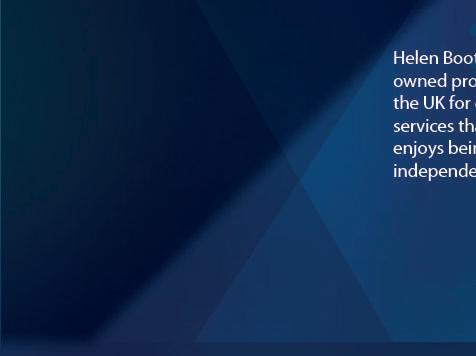

deVere France S.a.r.l. are regulated by ANACOFI-CIF and ORIAS which will only


Helen Booth works as a financial adviser for deVere France S.a.r.l and has lived as well as owned property in the Deux-Sèvres region. Having worked in the financial services in the UK for over 15 years, Helen prides herself in being fully diploma-qualified for the services that she provides. Helen has lived and worked in France for over 8 years and enjoys being part of deVere France S.a.r.l., a division of one of the world’s leading independent financial consultancies, deVere Group.
With over $10 billion of funds under its advice and administration and with more than 80,000 clients around the world, deVere Group truly offers a myriad of unique products and notes that are not available anywhere else in the market.

If you
The lump sum payment can cover the loss of income for your family
deVere France can advise you on ways to help safeguard and increase your wealth, as well as helping with HMRC-recognised pension transfers to a Qualified Recognised Overseas Pensions scheme (QROPS) to give you potentially more flexibility in your
Helen Booth DipPFS , EFA : +33 (0) 77 171 2879 : helen.booth@devere-france.fr
Dénomination sociale: deVere France S.a.r.l, RCS B 528949837, 29 Rue Taitbout, 75009, Paris, France. Gérant: Mr. Jason Trowles. Registre avec ANACOFI-CIF (Association Nationale des Conseils Financiers). Nombre enregistré: E008176, association agréée par l’Autorité des Marchés Financiers. Courtier d’assurances ou de réassurance, Catégorie B, inscrit à l’Organisme pour le Registre des Intermédiaires en Assurance (ORIAS) numéro enregistré 12064640. Garantie Financière et Assurance de Responsabilité Civile Professionnelle conformes aux articles L 541-3 du Code Monétaire et Financier et L 512-6 et 512-7 du Code des Assurances. Registered name: deVere France S.a.r.l, registered company number RCS B 528949837, 29 Rue Taitbout, 75009, Paris, France. Gérant: Mr. Jason Trowles. Registered with ANACOFI-CIF (National Association of Financial Advisers). Registered number: E008176, association approved by the
and
brokers, Category B, registered with the Organisation for the Registration of Assurance Intermediaries (ORIAS). Registered number 12064640.
conforms to article L 541-3 of the Monetary and Fiscal Code and L 512-6 and 512-7 of
28 etcetera
Financial Markets Authority. Insurance
Liability Insurance
Assurance
6XKWSX
re-insurance
Financial and Professional
Guarantee
the
Code.
•V1.1/230418
business

Nutritious Nourishment
Foods That Will Boost Your Brainpower!
WHY IS IT THAT SOME OF US HAVE THAT NIGGLING FEELING THAT OUR MEMORY ISN’T WHAT IT WAS?
Is memory decline an inevitable part of getting old? Is developing dementia a legitimate worry or do you just have too much going on?
Could it be your diet?
The ‘tip of the tongue’ syndrome is that feeling where you know what you want to say, you just can’t find the right word. Losing the car keys or your card, over and over. Not remembering place names, events, people or procedures. Being told that you don’t pay attention or you don’t listen when you are sure that you are really trying, it’s just so hard to remember.
In our brains we form memories using a substance called acetylcholine. We need to have the right ingredients in the body for acetylcholine to be made. Choline is used to do this and we get it mostly from egg yolks. Choline is also present in liver, animal protein, and fish. There is also some choline in tofu.


Amanda is a registered Naturopath and Nutritional Therapist, specialising in Nutrigenomics, the science of how your DNA is affected by your lifestyle and diet. She works with clients around the world from her Private Online Clinical Practice.
www.amandakingnd.com
Email:nutrition@amanda kingnd.com
Not remembering place names, events, people or procedures
It is very difficult to get enough choline on a vegetarian diet, let alone a vegan diet, but you can and I think definitely should supplement if eating choline-rich foods isn’t possible.
If you are deficient in choline, you will experience memory and concentration issues, brain fog, fatigue, anxiety, and ADHD-like symptoms. I have worked with many children who were, or were about to be, diagnosed with ADHD, who experienced a ‘remission’ when they started supplementing choline. Perhaps it was just a choline deficiency after all.
Some people have what we call SNPs (singular nucleotide polymorphisms) which are genetic mutations on their genes, in particular the gene called PEMT,
etcetera 29
health






du Champ de Foire aux Moutons 86150 L'ISLE JOURDAIN

British Psychological Society Nicholas SEAGRAVE M.B.P.s.S. Psychologue / Psychologist www.psychologist-seagrave.com Maison de Santé






30 etcetera
Mob
Face to Face / Video Call PSYCHOTHERAPY AND COUNSELLING SERVICE N° ADELI 86 93 03 86 Couples Counselling Mental Wellbeing
07 Email:
www.rootscounselling.fr Face-to-Face or Jill Martin MSc Counsellor Counselling and Psychotherapy Rafaël Dupré, BSc, MBCAP, PGCE Over 20 years’ experience. Fluent English rafael@a-therapy.com t. 07 83 23 77 23 Supportive Counselling for Positive Change No matter what
situation,
the safe, non-judgmental
confidential space
need siret 90793106700017 health Spa days
Spa Nights
hut tub, massage
lunch
supper
available. Specialist
Head,
Rejuvenation, Shiatsu ‘pop-up’ Cooking classes with Nikki & with Sean www.underthelimetree.com email: nikki@underthelimetree.com Fontfaix le Haut, 16260 Cellefrouin 05 45 84 91 79 / 06 47 24 34 61 HAIRDRESSER ANNETTE VAN ES Chez Martin 16150 Pressignac For an appt please contact: 05.45.71.56.02 06.50.23.61.37 annette.vanes@orange.fr siret: 518 364 989 00013 Depts 86 & 87 32 plus years’ experience Professional colouring and cutting services www.facebook.com/mobilecoiff READ REVIEWS ON ! ! Mobile Hairdressing MWP Hair 9 Grande Rue - 87210 Le Dorat 06 47 43 01 66 Natural Insect Repellent ▪ Protects skin from insect bites ▪ Easily absorbed ▪ No harmful chemicals - safe for children ▪ Available in a cream or spray ▪ Tested in more than a dozen countries worldwide www.bellefrance.org Belle Fleur Free delivery for orders of 25€ or more Siret 851 586 354 00017 Bellefleur & Firefly LOCAL STOCKISTS OR ORDER ONLINE carolynwatts385@gmail.com emmajhodgson@hotmail.co.uk 0656 872967 (Fr mob) 07870 667159 (UK mob) Mobile Service from 87440 Swedish Massage Sports Massage Reflexology Myofascial Release EFT siret: 85160551900012 well-beingtherapies
Amanda King BSc (OPEN) Dip. Nut. CNM nutrition@amandakingnd.com t. 06 32 83 12 79 Siret 91503451600012 Focusing on the root cause, not symptoms Fatigue • Poor sleep • Weight issues Hormonal Fluctuations • Menopause Fertility, Pregnancy and Breastfeeding Chronic illness • Diabetes • Cancer • Arthritis Sports nutrition • Thyroid support Depression or Anxiety • Chronic Pain Val Seger-Bernard Dip.Couns, M.Sc Psychology & Counselling Maison de Santé, Availles Limousine 30+ yrs experience in NHS/Education Face-to-face or online www.maisondolivecounselling.com E: info@maisondolivecounselling.com T: +33 7 68 62 83 22 Siret: 978 047 744 00013
The
Place
Email: seagrave.psy@gmail.com
: 07 77 26 10 63
Tel. 06 48 96 02
jillm@rootscounselling.fr
your
I’m here to provide you with
and
you
/
:
+
/
+ b&b. Gift vouchers
in Hot Stones Massage, Indian
Reiki, Facelift
Naturopathic Nutritionist


which we can easily test you for with a methylation DNA test. Many people have a need for extra choline and aren’t aware of this, so they more easily develop symptoms when their dietary supply falls short.
Another substance that helps with memory is something called DHA (docosahexaenoic acid) which is something that your body makes from omega-3 fish oils. You can get some omega-3 from plant sources but far and away the best source is oily fish like mackerel, salmon, and sardines. The added bonus with tinned mackerel and sardines is that they are small, portable, and make a great lunch or snack, as do boiled eggs.
converts into sugar, has growing evidence of being a contributor to the development and progression of Alzheimer’s.
(Alzheimer's disease is influenced by a combination of genetic, lifestyle, and environmental factors. While diet is a significant factor, it is one of many.).
It’s not just about what you do eat, it’s also about what you don’t eat.
Ideally children and smaller framed people would eat at least 1 egg a day but larger frames would eat 2-4 eggs a day, especially if active.
Regular exercise, being a part of a community, and spending time with friends and loved ones are also associated with better working memory
“A study published in Nutrients (journal) found that levels of DHA in red blood cells was related to Alzheimer’s risk. Those with the highest levels of DHA had a staggering 49% lower risk of Alzheimer’s related to the lowest DHA group”Mark Hyman
The brain is made of DHA and DHA is also anti-inflammatory. Sugar and empty carbohydrates from bread/wheat/grains contribute to inflammation which could lead to the progression of dementia. Alzheimer’s is now known as type 3 diabetes. Sugar in its many forms (granulated sugar, syrup, glucose or fructose, or in the form of empty carbohydrates like bread, wheat flour, and pasta) which the body easily and readily
Eat liver once a week . Some animal protein every day, we need around 0.8g of protein for each kilo we weigh and if we are active, following a ketogenic diet or weightlifting, we will need more (take professional advice).
I recommend at least 8 vegetables a day with two leafy greens so that you have enough of the right antioxidants that you need to use the choline properly (like PQQ from green peppers) and of course good quality animal fats and olive oil.
Remember also that there are lifestyle factors at play as well as diet. Regular exercise, being a part of a community, and spending time with friends and loved ones are also associated with better working memory and better physical and mental health. So why not join or even start a walking group in your local community and cover all these bases at once.
FOODS THAT DAMAGE MEMORY
Sugar
Wheat
Vegetable oils including sunflower/rapeseed (tournesol/colza) and margarine including ‘cholesterol lowering spreads’
Alcohol
FOODS THAT ENHANCE MEMORY
Eggs in particular the uncooked yolks - cooked is also fine
Liver
Animal protein, ideally organic and/or grass fed.
Fish
Oily fish in particular
health These articles are for information purposes only and do no constitute personal advice. For personal advice, reach out to your healthcare provider. etcetera 31

Getting out of the Rut
FEELING STUCK IN A RUT IS A COMMON EXPERIENCE THAT MANY PEOPLE FACE AT DIFFERENT POINTS IN THEIR LIVES. THAT UNSETTLING SENSATION OF BEING CAUGHT IN A CYCLE OF MONOTONY, WHERE DAILY ROUTINES FEEL REPETITIVE AND UNFULFILLING… SO HOW DO WE GET OUT OF IT?
This state of stagnation can affect various aspects of life, including career, relationships, and personal growth. Often, it’s accompanied by a sense of frustration and a longing for change, yet finding the motivation or direction to break free can be challenging.
I can’t seem to get out of this rut’
‘My mood has been low for a while now and it doesn’t seem to lift’
‘I feel unmotivated and don’t seem to get around to doing anything’
Sound familiar?
It does to me. These are remarks I hear on a regular basis in the practice room when working with people with dysthymia, the mild chronic form of depression or anhedonia which is the loss of pleasure. There are myriad reasons why one can feel this way and they are worth exploring. We want to understand and create awareness of underlying patterns and for people to change those unhelpful thoughts or patterns so they are able to move forward. Then they can feel generally lighter and more content again. That’s what we do in therapy. There is seldom a quick fix and it can take some time to reset and create more helpful thought patterns or behaviours. Little tricks or shortcuts to cope better in the meantime can come in handy. We still need to have a look at the root of this situation of course, but that doesn’t mean we can’t start moving forward in the meantime.
lighter and more motivated, but also on the many things you have achieved in this relatively short period of time.

 ByRafaëlDupré
ByRafaëlDupré
Originally from Belgium, Rafaël has run private practices in the UK and France, working with individuals or couples on a huge range of issues
rafael@a-therapy.com t. 07 83 23 77 23
Advert on page 30
walk then maybe try out a new route or ask a friend to join you. It all adds to the level of success that you experience and thus to the level of contentment.
There is seldom a quick fix and it can take some time to reset and create more helpful thought patterns or behaviours
A critical task can be any task you set for yourself that adds to your quality of life. We don’t need to look too far for this, it can be simply going for a walk, cooking a healthy meal, finally tidying up that room or making a phone call to an old friend. Get yourself a notebook and every morning write down 5 simple tasks you want to accomplish that day. Using pen and paper can seem a bit old-fashioned, but it is actually proven that handwriting feeds into our creativity and generates up to 4 times more ideas. You are also 3 times less likely to be distracted than when you are working on a screen. On top of that, we have a much better retention rate when we write things down than when we work on a screen. You also get to physically cross things off as you complete each critical task. Every time you cross something off, you experience a sense of achievement or success, which in turn gives you a little dopamine hit, one of your feel-good hormones that make you feel lighter and happier.
Making the list in the morning is a form of visualisation. You are literally visualising what your day will look like, what you will achieve and even how content you might feel at the end of the day having crossed off all five critical tasks. It gives you more purpose and direction. It gives you something to look forward to rather than getting lost in the rabbit hole of unhelpful thoughts or worries. You might also surprise yourself and complete your tasks a lot faster than you imagined, which in itself is a success and ensures some extra dopamine to enjoy. When you look at your list at night, you will be able to see what you achieved which may bring a smile. There might have been some difficulties that day and your general situation probably won’t have changed, but you did something well.
One way to break the general apathy and listlessness that many people feel in a fairly short period of time is creating the habit of setting and doing 5 critical tasks every day. Now, it takes time to form a new habit, it doesn’t happen overnight, so it is important to stick to this for at least a month. After this month you can evaluate and look back on not only how you feel
It is important of course that the tasks you set for yourself are achievable, and that they don’t take too much time or energy so you can complete all five by the end of the day. So be kind to yourself and don’t set the bar too high to start with. You can always challenge yourself a bit more once you have made a start and you feel you are on a roll. Also be mindful that you don’t repeat the same task too often, and that elements of your daily routine don’t end up on the list. Try to be a little creative and maybe even adventurous. If one of your tasks is cooking a healthy meal for instance, then maybe choose something to cook you never tried before. If you go for a
What if you don’t complete the list and you have a task left over at the end of the day? There is no need to be hard on yourself and beat yourself up over it. That would undo the feeling of success you worked for, so try to be proud of what you did achieve rather than focussing on what you didn’t. Just move the unaccomplished task to the next day and carry on, one day at the time.
Not only will this little trick benefit your mental health in the immediate future, you might also get on top of some long overdue chores or admin because you are generally more productive. It could very well benefit relationships with your partner, kids, relatives, and friends. As with most things mental health related, small, positive, incremental changes have a ripple effect on your wider well-being and on the people around you. So give it a go and make a start to get on track again to feel more in control of how you feel and definitely feel more content.
health
etcetera 33

Summer Gardens
SUMMER IS OFFICIALLY HERE! SUN AND HEAT ARE THE ORDER OF THE DAY IN MOST AREAS, BUT I WONDER HOW LONG IT WILL BE BEFORE WE ALL RECEIVE DROUGHT WARNINGS!
The start of summer, synonymous with simple outdoor pleasures, has been long-awaited this year, especially following the cold spring which seemed to last forever with strong winds and periods of heavy rain. Now it’s time to enjoy the flavours, textures, colours, and scents that burst out at this time of year, so try to make time to appreciate them.
As we go into summer, watering the garden will become increasingly important to keep our plants healthy, but there is also the imperative to safeguard the planet’s decreasing stored supply of water.
We need to ensure we give our plants the water they really need in a way and at a time best for the plants and the planet. It can be difficult to work out whether to water or not. The easiest way to see if water is really needed is to put your hands into the soil to check how deep water has percolated. Often we think that a rain shower is enough but when we scrape the surface of the soil, it is only wet for a few

 ByRonnieOgier
ByRonnieOgier
Ronnie is a passionate gardener and now loves sharing her years of experience of success and failures in her own garden and sharing it with you. Also a keen runner, having been bitten by the ‘Couch to 5K’ bug!
millimetres. This is when water is needed, even if it has rained. The other thing to remember is that when the sun shines through a cloudless sky, or even when there is cloud cover, evaporation is strong.
Often we think that a rain shower is enough but when we scrape the surface of the soil, it is only wet for a few millimetres
In order to balance this difficult conundrum –water or no water –there are useful guidelines about watering to reduce wastage and to give best value to the plants:
34 etcetera

1. Always water directly at the base of the plants as this cools the base of the plant and gives a better chance to supply the plants’ roots with the water they need.
2. Water in the evening to replenish water lost during the day through evaporation.
3. Save water that has been used in the house for rinsing vegetables, from the shower or from cooking vegetables. Be cautious about using washing-up water as it could be greasy.
4. And, as I regularly advocate, put a thick organic mulch at the base of the plants to help limit evaporation and reduce the frequency of watering.
5. Setting up an automatic drip irrigation system is an efficient, lowcost, and economical way to irrigate, provided that you use a timer and water overnight. This also reduces the chance of plants drying out if you are away from home for a period of time. If watering really isn't your thing then opt for plants with lower water needs such as cactus or succulents. There are some plants which are more drought resistant than others. These include shrubs such as perovskia, ceanothus, buddlhia, and escallonia. These, along with droughtresistant perennials such as euphorbia, sedum, salvias, oesteospernum, lavander, and cineraria, could make your gardening a lot easier. But don't forget that all newly planted plants will need watering to settle in, but then they should last you for many years.
At this time of year our focus needs to be on keeping our flowers going for as long as possible, and so pinching out is important to do in June as it encourages plants to branch out, produce more stems, and therefore more flowers. To pinch out, nip off the stem tip between the thumbnails and index fingernails just above a young pair of leaves. Pinching out the young stems of climbing plants will give them a more compact habit, thicken the base, and force them to branch. Pinching out annuals such as petunias, marigolds, cosmos, nasturtiums, and pelargoniums helps to avoid too much seed production as when seeds are produced the plant thinks that its job is done and no more flowers are needed. Removing faded flowers from perennials, including roses,
will prolong flowering through late summer and into autumn.
From mid-June, secateurs come back into their own as a key tool in the garden, so much so that they will almost become an extension of your hand! Prune all suckers growing at the base of trees and shrubs and remember to remove new growth that appears from the grafting point of roses. Finally, prune shrubs that bloomed in the spring such as spirea, forsythia, and lilac.
Early in the month it’s still not too late to do the ‘Chelsea Chop’. This is the English gardener’s miracle cure! It makes many herbaceous plants grow bushier and it extends their flowering period for as much as four to six weeks, depending on the plant. Plants that receive the Chelsea Chop are not as tall or leggy, so that they may not need supporting. Flowers are smaller but are more numerous, the removal of top shoots encourages branching of laterals.
Then, when the first flowering period is almost over on the shoots you haven’t cut, the buds will start to open on the newly sprouted stems. Many summer and autumn flowering perennials are good candidates for the chop. These plants include Phlox paniculata, Achillea, Campanula, Echinacea, Rudbeckia, and Penstemon.
Early in the month it’s still not too late to do the ‘Chelsea Chop’
It is hard to be this severe with your beloved, freshly-sprouted plant babies, especially when they’ve already grown nice and tall, but it’s worth it. The Chelsea Chop will even stop sedum from getting too heavy and falling apart, as it often tends to do. Once you’ve ‘chopped’ your plants, give them a good drink and throw on a little fertiliser. Oh, and one more thing: you can always try growing new plants from the cuttings. This works particularly well with sedum. Just place the cut shoots in water, and you won't have to wait long for new roots to start growing.
It’s a pruning method carried out at the end of May/beginning of June – around the time of the legendary Chelsea Flower Show in London. For plants like catmint and sedum, which will usually have fallen apart by the end of summer, it will encourage them to stay upright into the autumn. This pruning should be done before the onset of our hotter, drier weather so that it does not overly stress the plant, on average by mid-June. The Chelsea Chop – so how does it work? Using phlox as an example, don’t cut the whole phlox. It would be possible and would make the plant much more compact, but you’d lose out on that long flowering period, which – for me – is the primary benefit. The chop is done in two ways depending on the effect you want. In the first method, clumps of perennials are cut back by one third to one half. This will delay flowering and keep plants shorter and more compact. The second method involves cutting back around a quarter to a half of the stems on a plant - this has the effect of extending the flowering season over a longer period. I prefer to use the second method on my phlox, keeping the plants in bloom for a longer time. Where you’ve cut the phlox it will develop new shoots, and on these new buds will form. That means that not only will your plant become bushier and more sturdy, but you’ll also get a delayed second bloom.
It should be noted that you can’t chop all summer blooming plants. Woody subshrubs do not respond well, and it doesn’t work with all flowers – some examples of that are peonies, columbine, and hydrangeas. And yet again don’t confuse the Chelsea Chop with “normal” pruning, which takes place AFTER the flowering period has finished and will promote a second flush of flowering. Plants which will regularly send up a second flush of flowers if the flower stems are cut back to the ground after flowering include delphiniums, foxgloves, hollyhocks, astrantia, and lupins.
But even in a well stocked and well maintained garden, most of us will find ‘chores’ to get on with - removing side shoots from tomato and aubergine plants, and pinching out courgettes, cucumbers, squash, and melons. By pinching out these plants when they have at least 4 true leaves, just above the first 2 leaves, the plants will branch well. New stems will form - these can also be pinched out, but this time above the third leaf. Repeat the operation once more on the new stems and then let the fruit appear. When they are the size of a marble, prune above the second leaf just after the fruit.
Even though I suggest we should relax and enjoy our gardens now there is still such a lot to do! Happy Gardening!

garden




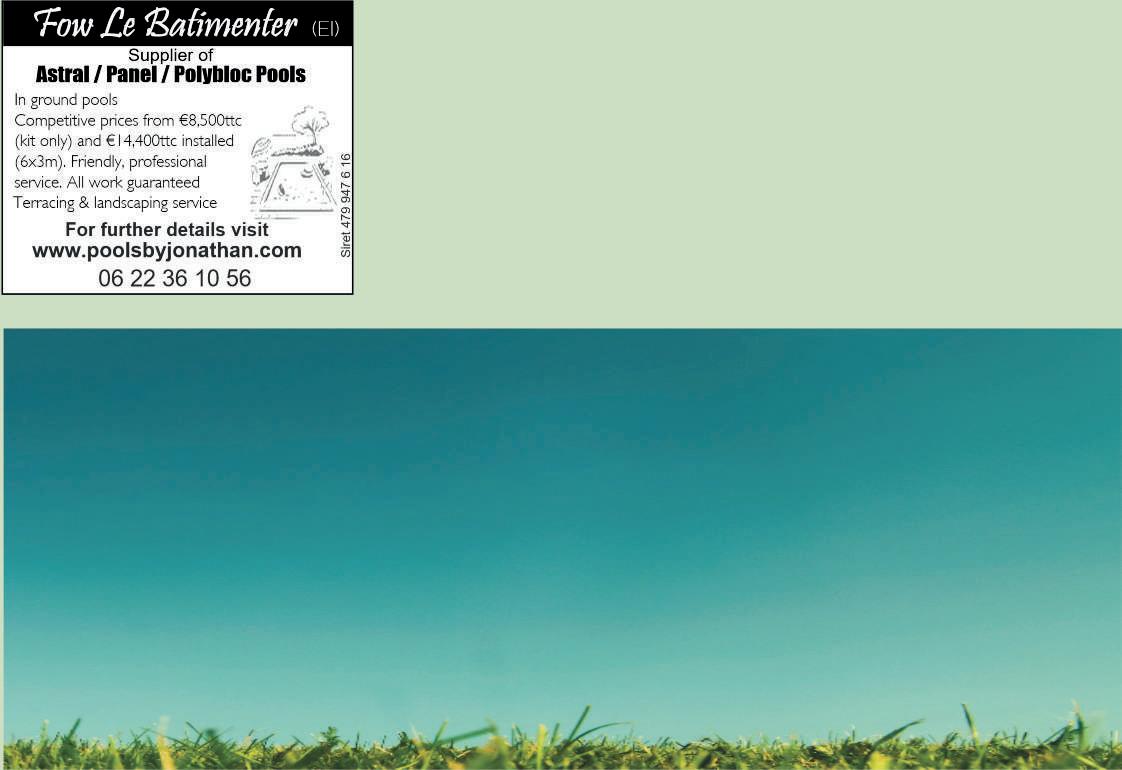








36 etcetera garden Tel: Frank Hawkins 05 55 71 43 38 Email: sparksstudio@yahoo.com Facebook: Hawkins Gardening Services Siret: 514 758 028 00013 Areas covered 87 & 24 HAWKINS GARDENING SERVICES (EI) ~ Grass Cutting ~ Hedge Trimming - Fencing - Strimming - Garden Clearance All Aspects of Garden work undertaken HOT TUBS AND SAUNAS IN FRANCE KICK BACK AND RELAX www.hottubsinfrance.com FR: 0749 19 46 84 / UK: 0784 575 40 49 Summer Event Sunday 23 June







~ Hedgecutting and paddock mowing
~ Flail mowing for rough/long grass areas
~ All excavations and groundworks undertaken
~ Woodchipper and operator for hire
~ All fencing carried out
~ Patio's, driveways and excavations







etcetera 37
EI
Alan Schofield
32 years’ experience Free estimates FENCING • Agricultural/Equestrian • Garden • Swimming Pool GATES • 5-Bar Field/Entrance • Garden • Driveway Neil: 05 55 00 08 90 / Mob: 06 11 71 66 87 garden LES BASSINS DE FAYOLLES ZAC Les champs de la grange 86400 SAVIGNE contact@bassinsdefayolles.fr 05.49.87.07.78 POOL CREATION IN THEVIENNE RENOVATION OF ALL BRANDS SPA WATER ANALYSIS DECORATION @MAGILINE86 SUIVEZ-NOUS EI BDCR 87 Insured professional Covering depts 87, 16, 24 Siret 890 710 940 00010 09 80 57 01 05 or 06 44 79 98 26 Email: BDCR87@hotmail.com Alistair Clarke Trees felled ~ Branches chipped Stump grinding Hedge reductions and removal Overgrown jungles cleared Insurance work undertaken 50% discount available Enquire for eligibility The Homecheckers For your unoccupied home solutions, whether you're away for a few days, weeks, or months Unoccupied Homes Checked • House & Garden Maintenance • Key Holding • Mail Forwarding Meter reading… & much more • Fully Insured Thehomecheckers.fr T. 06 71 07 45 38 / 0044 7481 475 379 Email: thehomecheckers.fr@outlook.com Based in 79190 Sauzé-Vaussais Siret 90185483600011 editors.etcetera@gmail.com www.etceteraonline.org AdvertiseYour Business From as little as 39€ ttc siret51325382300019 ● Now offering full landscaping ● Tree surgery by Darren ● Gates and fencing ● Patio and fosse installations UNDER NEW OWNERSHIP Contact Gwenn Demezil creatifpaysage@orange.fr

Container Gardening
I AM OFTEN ASKED BY NURSERY CUSTOMERS, ‘CAN I GROW THIS PLANT IN A POT’, AND I USUALLY SAY IT IS POSSIBLE TO GROW ANY PLANT IN A POT, BUT SOME ARE MORE SUITABLE THAN OTHERS
Some do not thrive in the restricted root environment, and some are just not decorative enough - for example they may only flower for 3 weeks of the year and then die back, or the foliage is simply not very attractive. To create a display with impact you need to pack your containers with interest for as long as possible. Summer is the time of year when the streets are adorned with pots of flowers, the roundabouts are bright with colour, and the municipal displays are packed with vibrancy. This type of display
is generally made up of annuals and tender perennials because they flower for a very long season and therefore give longlasting colour.
Pack your containers with interest for as long as possible
Tender perennials are plants that live for many years but they do not withstand the frost and the wet weather of the winter outside so they need protection. If you have somewhere frostfree to keep them over winter then it is possible to keep them going for the following year, but they are often leggy


Caroline has been a lecturer in horticulture for 20 years and now runs a nursery and ‘garden craft’ courses in the Haute-Vienne at Le jardin créatif
and less vigorous. Hence why commercially they are produced fresh each year from either seed or cuttings so that the young plants perform well all summer. These types of plants are often referred to as ‘bedding plants’ and include the popular Pelargoniums (commonly referred to as geraniums – although they are related, they are not true geraniums), Petunia, Begonia etc. They originate from warmer climates where they can grow all year round and flower for most of the year. When making up a container of summer bedding plants, the traditional ‘thriller,
Caroline Wright Le jardin créatif
garden 38 etcetera
spiller and filler’ arrangement works well for a display full of interest. This refers to choosing three different plants: one that is more upright and striking (thriller), one that trails (spiller), and one that is more spreading and frothy (filler). Common examples of these are:
Thrillers: Aeonium, Cordyline, Nicotiana, Snapdragons, Curly Kale, Dahlia
Spillers: Fuchsia, Petunia, Surfinia, Nasturtium
Fillers: Pelargonium, Begonia, Nemesia & Diascia, Cuphea
For more permanent container displays you need to choose plants that have a long season of interest and think more about the foliage than the flowers. Herbaceous perennials are not a good choice for planting singularly in containers because their flowering season is often short lived, and they are best grown in borders with other perennials that will give a succession of interest over the growing season.
Evergreen variegated shrubs, Salvia, ornamental grasses, succulents, and palms are a better choice because they will be more decorative over a long period of time.
Herbs are good in containers because you can have them by the front door so that they are handy to gather for cooking. Vegetables generally need good root space and can be short-lived and most are not really suitable for containers, but curly kale has colourful, frilly foliage and can be grown for its decorative appearance mixed with summer bedding plants - I have found that this is also a good way to avoid
flea beetle so you can harvest the leaves when the display is over.
Some fruits are suitable in containers, particularly citrus fruits and olives that need winter protection.
The choice of container will be down to the size of the plant and your budget. Plastic containers are a cheaper option and they are lightweight and much easier to move around, while ceramic containers are more decorative but tend to be more expensive and can be very heavy so if you are planting them up with something that needs to be brought in for protection for the winter they may not be the best choice. Wooden planters are somewhere in between, price and weight wise, but they tend to rot after a few years as they are constantly wet. You can use upcycled or ‘repurposed’ containers such as pots and pans and old cauldrons, but they will need adequate drainage holes drilling in the bottom and metal containers can get very hot if they are out in the sun which can kill the roots of the plants, so metal containers are best where they do not get the extreme heat of the afternoon sun on them. To drill holes in the base of repurposed ceramic pots you will need to use a special drill bit for ceramics and glass. I love to have fun planting up old tea pots and jugs with succulents that can cope with a very limited root zone and tolerate being dry. Always use a good quality potting compost and, if possible, add some slow-release fertiliser; plants growing in limited root zones will quickly run out of nutrients. If
this happens they will become stunted, the leaves will go pale, and they will not flower or fruit well. Alternatively, you can use a liquid feed such as a tomato feed once a week during the growing season. If possible they will need to go into a bigger pot each year at the start of the growing season with some fresh compost, but if you are unable to pot them on, they will need top dressing with a fresh layer of compost and fertiliser. If possible, remove the top couple of inches of the old compost before doing this.
Never use garden soil or manure in a container
Never use garden soil or manure in a container. Manure is too harsh. You can use sterilised soil mixed into the potting compost which is beneficial for permanent planters because the clay in the soil helps to stabilise the medium and holds onto nutrients and water, but no more than 30% of the overall volume. Fresh garden soil will contain weed seeds, pests, and diseases, and should be avoided. Soil is sterilised traditionally by steaming it to make the ‘John Innes’ type compost blends. It is possible to do this in an oven at home by putting damp soil into an old oven dish, cover with tin foil, and ‘bake’ for 20 minutes at 80 degrees! Watering is often the main issue. The compost will dry out very quickly in summer and you may need to water the containers every day. Use collected rainwater whenever possible, or use grey water such as dishwater. We also have a bucket under the bathroom outlet that collects water from the shower.


nursery and garden are open every Saturday 10h00-16h00 until late October.
garden etcetera 39
At
You
about
lejardincreatif.net
Le Jardin Créatif Our
can also browse our plant list and find out
our garden craft courses on our website:





free time 40 etcetera
etcetera 41 free time

The Night Sky
THIS MONTH, WE CELEBRATE THE SUMMER SOLSTICE ON THE 20TH OF JUNE AND VIEW SOME BEAUTIFUL SUMMERTIME CELESTIAL SIGHTS
At 22h50 the Sun will be positioned at its farthest north point in the stars and in astronomical terms it marks the start of summer. This lasts until the autumnal equinox in September. We can enjoy the beautiful asterism 'The Summer Triangle' all month. It is an easy triangular pattern formed by the bright stars Denab (in Cygnus), Vega (in Lyra), and Altair (in Aquila). This triangular pattern can help to point the way towards many other summer constellations. We can enjoy the return of the planets Mercury, Mars, and Jupiter this month. Read on for more details of when and where to try to spot them. There will also be a conjunction of Jupiter and Mercury to look for on the 4th of the month. June is the time to look out for the very special annual event 'On The Moon Again'. You can search online or follow the group on Facebook www.facebook.com/onthemoonagain to find out if there is an event being hosted in your location. This international astronomy event is planned during the weekend which falls closest to the anniversary of the first Moon landing date. This year the event will run from 14th to 16th June. It is a fun way to share a little astronomy with others and learn while observing. I have hosted a number of these events in our own village during the last few years.
Moon Phases and Observing ideas
New Moon Phase: 6th June at around 13h40
First Quarter Phase: 14th 6h20
Full Moon Phase: 22nd just after 2h00
Last Quarter Phase: 28th just before 23h00.
We could have the chance to observe an interesting conjunction between the planets Jupiter and Mercury this month. This could be visible in the morning of the 4th, after 11h00, and only 12 degrees away from the Sun. As this is a daylight conjunction it will be necessary to use good binoculars or a small telescope to observe. Both Mercury and Jupiter are bright so if you can, find them as they rise in the early hours and follow them during the morning as they seem to move closer together. Do not look directly at the sun with your eyes or any type of observing equipment.
Planets this Month

ClaireWardlaw
14-16
June
2024
Claire Wardlaw, originally from Edinburgh, lives in the Charente with her husband. Since their move to France, Claire has become passionate about astronomy

Mercury will be best viewed in the evening sky at the end of June.
Mars will rise almost three hours before sunrise so, if you are up and about, look for it on the eastern horizon towards the end of the month.
Jupiter is getting better every month now and may be seen close to Mars on the 4th, as mentioned above, looking southeast.
Astronomy Jargon Buster : Solstice
This triangular pattern can help to point the way towards many other summer constellations
The solstice (combining the Latin words sol for “Sun” and sistere for “To Stand Still”) is the point where the Sun appears to reach either its highest or lowest point in the sky for the year and thus ancient astronomers came to know the day as one where the Sun appeared to stand still. The two solstices happen in June (20th or 21st) and December (21st or 22nd). These are the days when the Sun's path in the sky is the farthest north or south from the equator. A hemisphere's winter solstice is the shortest day of the year and its summer solstice the year's longest day.
A few of the planets are improving for observation this month:
 Happy Star Gazing!
Happy Star Gazing!
42 etcetera astronomy



Geminiano Montanari (1st June 1633 – 13th October 1687) was an Italian astronomer, lens-maker, and proponent of the experimental approach to science. He was a member of various learned academies, notably the Accademia dei Gelati. Montanari's famous students include Domenico Guglielmini, Francesco Bianchini, Gianantonio Davia, and Luigi Ferdinando Marsili.
He is best known for his observation, made around 1667, that the second-brightest star (called Algol as derived

from its name in Arabic) in the constellation of Perseus varied in brightness. It is likely that others had observed this effect before, but Montanari was the first named astronomer to record it. The star's names in Arabic, Hebrew, and other languages, all of which have a meaning of "ghoul" or "demon", imply that its unusual behaviour had long been recognised.
HISTORY




etcetera 43 astronomy
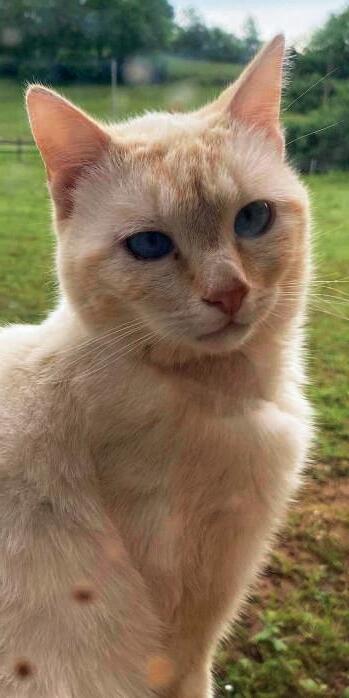









Les Amis des Animaux

THIS YEAR SEES THE 10TH ANNIVERSARY OF THE FOUNDING OF ASSOCIATION - OUR MISSION IS TO HELP ABANDONED, UNWANTED AND “DIFFICULT TO HELP” DOGS AND CATS FIND A NEW HOME
We are dedicated to helping reduce the animal abandonment problem in France by providing a compassionate and complete service for dogs and cats that are abandoned, unwanted, and in greatest need. We are also committed to providing animal welfare education.
At the heart of all of this is our community of fosterers who are our lifeblood. We do not have a refuge, kennels or a large home which can house several animals all at the same time. We rely utterly and absolutely on the kindheartedness of our selfless fosterers who will take in neonate puppies and kittens, older puppies and kittens, and adult cats and dogs with chronic conditions or who are simply in their twilight years.
are 11 cats in lifetime foster care and 94 were adopted into their new lives. Les Amis will rehome anywhere in France to suitable homes.
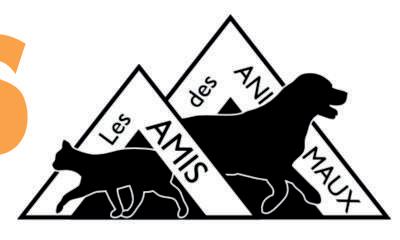 By Anne Grose
By Anne Grose
If you are looking for a dog or cat to join your family either as a fosterling or as a permanent member, we would love to hear from you
Last year 300 dogs were taken into foster care. 221 were found new homes and 79 have stayed in lifetime foster care. There
So, if you are looking for a dog or cat to join your family either as a fosterling or as a permanent member, we would love to hear from you. All dogs arriving under the Les Amis care spend some time in foster care, regardless of age or history. This allows us to deal with any immediate medical issues –including vaccinations, clearing parasites, and sterilisation - assess what they know and start the training process, and better understand each dog and their needs. We then prepare a profile for each dog covering what they are like and the type of environment that would best suit them, which is then shown on our website. This will help you choose the right dog for your situation.

Join our “Be My Friend” scheme to support lifetime foster dogs and cats, for as little as 5€ a month
All this, of course, costs money, and whilst we do ask for an adoption contribution to help cover the basic costs of preparing them for their new home, these do not cover all of our expenses, which last year amounted to €170,000. Obviously without funds we cannot continue with our work so we have a variety of ways in which people can help us. The “Be My Friend” scheme was launched last year to support the lifetime foster dogs and cats in our care. For a monthly donation of as little as 5€ you can become a friend and help with the costs. We also run a weekly auction on Facebook which started back in 2020. Every week, fantastic quality items are auctioned that range from gold, silver, and costume jewellery, household items, and clothes, up to artwork and dog and cat items. Donations of new or nearly-new quality items are always welcomed. Please visit our website to find out all about us, see the animals, and what you can do to help.
www.lesamisdesanimaux.com

Visit our Les Amis des Animaux Auction Page on Facebook and join our weekly fundraising auctions!
animal
From Foster to Forever Home www.lesamisdesanimaux.com






















animal 46 etcetera 30 mins from Limoges airport Rochechouart Individual/family units with outside areas Certificate in cat care awarded, Veterinary approved Inspection welcome (by apt) English & French spoken Run by Barbara, who loves cats Tel: 06 30 02 35 73 / 05 55 03 76 87 Email: bdowning77@wanadoo.fr www.rochechouartcattery.com LIME TREE KENNELS Siret: 822 175 527 0016 ● Purpose-built kennels ● Large secure paddock ● Large family kennels available Anita Frayling. Le Baillat, 16220 Rouzede Tel: 05 45 66 14 62 Email: anita.limetreekennels@gmail.com 15 mins La Rochefoucauld 20 mins Rochechouart New email address Chateau des Chiens (EI) Contact Chris T. 06 74 80 47 25 Email: chateaudeschiens@yahoo.com 79190 Limalonges Fully equipped, heated salon providing a safe, comfortable environment for your dog All dog types, sizes & temperaments catered for by a fully insured, experienced groomer siret 83786431300015 Doggy & Moggy Holidays & Hydrotherapy Centre We do doggy play days E: doggymoggyholidays@yahoo.com www.doggymoggyholidays.fr Thiat 87320 (10 mins north Le Dorat) We can care for your pet, aiming for your dogs and cats stay to be as enjoyable and stress-free as possible. From one day to several weeks HAPPY STAYS FOR DOGS AND CATS F ULLYAIR CONCATTERY T: Josie or Sean Schuster-Lammas (EI) 05 55 60 27 79 CLAUDE'S CAT HOTEL Les Chaillauds 16220 MONTBRON Tel: 05 45 24 01 45 claudescathotel@gmail.com www.claudescathotel.com "Cats don't have owners, cats have staff" Caroline Davis EI Linda Upfold 06 74 39 34 13 (16220 Montbron) pataplouf.toilettage@gmail.com Grooming Salon Dogs & Cats Dogs of All Sizes Welcome Bath • Scissor Cutting Clipping•NailsandEars Siret 45259669500034 Crofty’s Cuts Selection of collars and leads etc… Dog Grooming Siret 52475689700046 Call Lee on 07 88 66 54 38 www.facebook.com/croftyscuts 87190 Magnac Laval Supporting Local Business since 2006 Private pens, each with inside and outside space. Peaceful garden setting. Open 7 days a week. Viewings welcome by appointment. Recommendations available. Situated in Montemboeuf (16) Alison Sacco Tel: 07 52 94 37 48 E: alison@petite-paws.fr www.petite-paws.fr Petite Paws Cattery Certificates in cat care Siret: 87789319800011
Nocturnal Navigators

WE USUALLY ARE AWARE OF THESE BEAUTIFUL MAMMALS ONLY WHEN THEY FLY AROUND OUR EVENING PICNIC AT THE END OF A WARM SUMMER’S DAY
They confuse us with their different sizes, and they move so fast and are no more than silhouettes that to most of us they remain a mystery, even though we can clearly see them, so what more can we know?
But I’m frightened of bats
An awful lot of fallacies surround bats. They are blind (in fact, all bats can see very well); they hunt by radar (many use sonar echo-location to pursue their prey, but others hunt by eye); they easily get tangled in ladies’ hair (no bat worth its salt would ever get into that situation); they drink human blood (there are three bat species that drink blood, all tropical, and they prefer animal blood anyway); they spread rabies (there is only one known proven case of anyone so infected by a bat); they are harbingers of evil and bring a curse on any house they enter (oh, come on!). Be assured, if a bat gets into the living-part of your house, it will be very keen to leave. Open a window for it and it will fly straight out!
They do like churches, though. In the church where I was churchwarden a longeared bat would regularly enliven the service by flying up and down the aisle during the sermon. The vicar was most put out when I told him that the Wildlife and Countryside Act prevented him from doing anything about it. My suggestion that he emulate St Francis and preach to the bat did not improve his temper.
Bats are the only mammals that can truly fly, although one or two others can glide. They are not related to mice but occupy their own order Chiroptera (hand-wing), so named as their delicate and extraordinary wings are formed by membranes stretched across the fingers of the forelimbs.
Where do they live, and for how long?

 ByMikeGeorge
ByMikeGeorge
Mike George is our regular contributor on wildlife and the countryside in France. He is a geologist and naturalist, living in the Jurassic area of the Charente
Some live for up to 30 years. They only bear one pup every mating, however, and this is very vulnerable until it has matured, so the rate of increase in any bat colony is relatively slow even under ideal conditions.
It is by no means impossible to house a robust bat colony in your home and not even know it
They live a surprisingly long time. The tiny Pipistrelle can live for 12 years, and the average lifespan is 20 for larger bats.
Bats roost in any suitable shelter they can find. It is by no means impossible to house a robust bat colony in your home and not even know it, especially if you have an undeveloped grenier. They can foul buildings, but only slightly. Their droppings are dry and odourless, but their urine can be a problem. In St Paul’s Cathedral, there was one spot on a side-aisle where a dark, wet stain kept appearing on the reputed site of a martyrdom – the martyr’s phantom blood, of course! Dr Buckland, the eccentric 19th
The Grey Long-eared Bat Plecotus austriacus hunting in a forest, one of our largest bats, and feeds mainly on moths
etcetera 47

century naturalist, was shown the spot. He knelt down, applied his tongue to the stain, and pronounced that it was bats’ urine!
Incidentally, if you find droppings and you cannot tell whether they are from mice or bats (they do look very similar), the way to tell is to take the dry droppings, place them in the palm of your hand with the sun shining over your shoulder, and rub the droppings to powder with the finger of your other hand. Bat droppings will sparkle because of the fragments of chitin from the bodies of the insects they have eaten; mouse droppings will not. It sounds far-fetched, but I have done it and it works.
Bats destroy an enormous amount of pest insects – they have to consume their bodyweight in insects every night. A largish insectivorous bat can eat 1,200
mosquitoes in an hour. These bats tend to use echo-location to pinpoint their prey –ultrasonic pulses are emitted whose echo the bat can detect. However, this is by no means infallible. Some moths can emit their own sound pulses to interfere with the system. In Cyprus I watched bats, spot-lit by sodium lights, pursuing large, succulent-looking moths but swerving aside at the last moment, evidently confused by the moth’s sonar defence.

The Greater Horseshoe bat Rhinolophus ferrumequinum is the largest of the European horseshoe bats, the curious face configuration is an adaptation to improve echo-location
Arctic and Antarctic regions. Which are we likely to see in our corner of France? I list below the likeliest bats that you may encounter in Northern Aquitaine.
Bats destroy an enormous amount of pest insects –they have to consume their body-weight in insects every night
So what bats might we see?
Bats account for almost one quarter of the 1,100 mammal species on earth. They are found in all parts of the world except the
Horseshoe Bats (Greater and Lesser) are the largest, but are sadly in decline and becoming scarce. The Greater Horseshoe Bat is described as having a butterfly-like flight and is said to glide frequently. It can have a wingspan up to 35 cm (that’s about 14 inches in old money) making it quite a large animal. If you see the face up close, you will not mistake the horseshoe-like fold around the nose, which is an adaptation to improve the bat’s echo-location signal.
Long-eared Bats (Grey and Brown) are also large bats, comparable with the
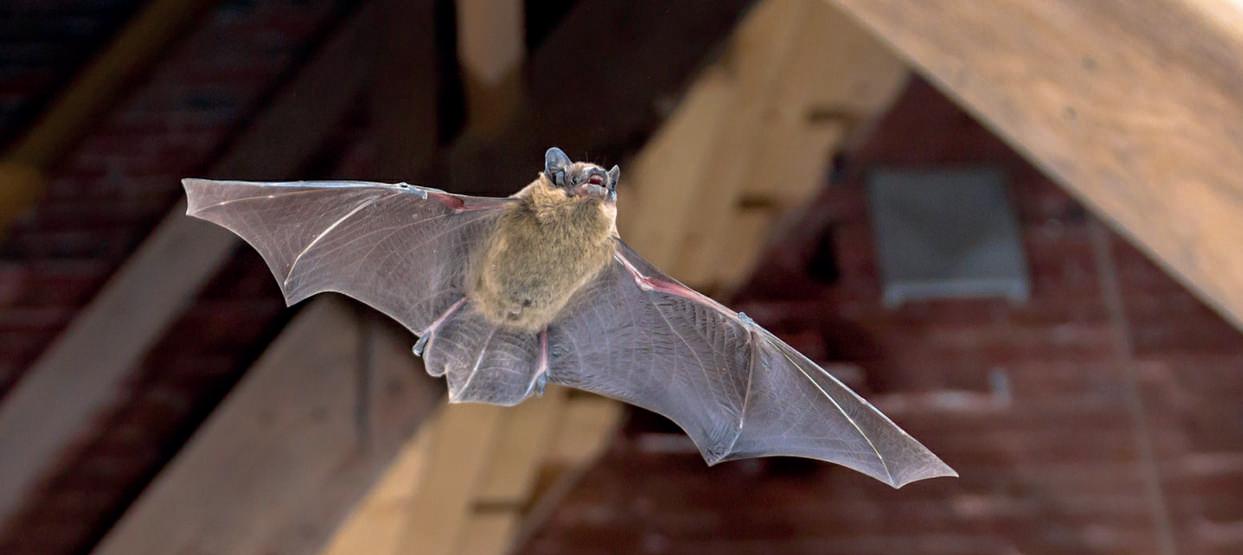
etcetera 48
Daubenton's Bat Myotis daubentonii and Brown Long-eared Bat Plecotus auritus overwintering in a military fort
Flying Pipistrelle bat Pipistrellus pipistrellus hunting in the wooden attic of a city church


Horseshoe Bats in size. Their distinguishing characteristic, not surprisingly, is that they have unusually long ears (the Brown Long-eared Bat can have 4cm long ears), with a prominent tragus (a vertical spike) sticking up in the aperture. Again, this is all an aid to their echo-location. The larger Grey Long-eared Bat is somewhat in decline.
The Noctule is a largish bat, up to 40 cm wingspan (but usually much smaller). It is distinctive in that it comes out to hunt an hour earlier than other bats, often with quite a lot of daylight left, and tends to fly high (50 metres or more). It is noticeably reddish. It also produces a loud metallic chirp, separate from its echo-location signal, which many humans can hear.
The Serotine is a moderately large bat, often seen flying at dusk with Swifts. It flies fairly low (lower than a Noctule). It is in some decline in parts of Europe, but in other places can be the dominant bat.
The Common Pipistrelle is the commonest bat throughout Europe, but is showing signs of declining. It is also the smallest bat, not exceeding 24 cm in wingspan. It can continue hunting later into the year than other bats, and is occasionally seen in mid-winter. Its flight is rather jerky, and rarely exceeds 10 metres above ground.


It tends to frequent wetter areas, and has the unusual ability to swim and take-off from water
Daubenton’s Bat is a small bat, slightly larger than the Pipstrelle. It tends to frequent wetter areas, and has the unusual ability to swim and take-off from water. It is also to be found with other bats in hunting groups. It seems, unlike most other bats, to be on the increase.
Wasp nest in a tree. Constructed entirely of chewed wood-fibre, forming a sort of paper. Note the typical grey-striped texture
I have seen specimens of the Brown Longeared Bat and Daubenton’s Bat in my garden (dead, sadly, so I had the leisure to identify them). The Serotine and the Common Pipistrelle are also likely candidates to be part of the evening bat display. There are of course many other species, but these are rare, declining and/or threatened, and only a bat expert would be able to spot them. And indeed, the size and the flightpattern are the only visual clues. The larger ones are likely to be Longeared Bats, but the smaller ones, to the non-expert, just flit around anonymously. The information I have given above is only really useful if you have the bat in your hand and, as a non-licensed person, you shouldn’t be doing that!
To be able to tell them apart reliably requires a clever box of electronics that can render their ultrasonic murmurings audible, and this must be supplemented by the expertise to identify those sounds. It helps to add a computer to display the graphs of the soundwaves and also to analyse them.
Bats can only fly when the temperature is above 8°C. In winter they either mass together for warmth and reduce their activity to a minimum, or hibernate. Some species can even survive being encased in ice for a limited time.
There are few things more relaxing than sitting out on a warm evening in summer, perhaps fortified with some refreshment, and watching the bats flying around you as night approaches. Just think of all the mosquitoes from which they are saving you, and the flying pests they are destroying, and quietly applaud them.
49 etcetera
Pipistrelle Bat Pipistrellus pipistrellus held in a human hand to give an indication of size
Natterer's bat Myotis nattereri in flight in a church tower. Note the bat's distinctive white belly











home and specialist 50 etcetera Wed - Sat 10am - 5pm Sunday afternoon Mobile 06 40 05 37 77 5 Place du Souvenir 86350 Saint-Martin-l'Ars E: frenchpolisherinfrance@gmail.com Robert Rose French Polisher in France La Source brocante - deco - furniture - gifts RESTORATION WORK UNDERTAKEN lasource86.com Affordable UK Designs UPVC & Aluminium Double Glazing, Fitted Kitchens www.affordableukdesigns.com Free plan, design and costing throughout South-West France - Other areas by arrangement UPVC windows, Doors & Conservatories in all colours and styles Aluminium and UPVC Bifold Doors Made to “A” Grade spec in French styles Siret: 513 577 809 00017 T: 05 49 42 99 41 ~ M: 06 63 71 09 81 Email: scott.braddock1@yahoo.com

















etcetera 51 EI Oven Cleaning Specialist Carpet/Rug & Upholstery Cleaning Using BIODEGRADABLE products Your oven will look shiny and new again Call Paula: 06 95 84 12 95 paulapowell@hotmail.co.uk www.facebook.com/foureclat PLUS Contact Nick on email: nickthesweep@gmail.com or T. 05 45 71 33 36 Siret 81968203000013 Chimney sweep Chimney sweep ● Certificates issued for every sweep
Over 10 years’ experience.
45 minutes radius 16240 Villefagnan
Registered Chambre de Métiers et de l'Artisanat Contact Paul on 06 60 07 54 78 or 05 45 84 27 75 www.facebook.com/PMCarpets Email paul.marshall@pmcarpetsandflooring.com ▪ We supply and fit a wide range of carpets, vinyl and luxury vinyl tiles ▪ Over 40 years’ experience in the trade, 100% customer satisfaction PM CARPETS& FLOORING PM CARPETS & FLOORING For All Your Flooring Needs www.pmcarpetsandflooring.com CLEANING & RESTORATION SERVICES Email: james@revive-cleaning.fr Facebook: Revive-cleaning Hardfloor, Tile, Grout, Stone Cleaning & Sealing ~ Pressure Washing, Carpet and Upholstery Cleaning ~ Vehicle Valeting, Headlamp Restoration Siret 951 579 267 00018 home and specialist XP Flooring James Nelson Your dream home, our mission Installation and/or supply of carpets, vinyl, laminate, luxury vinyl tiles, and wet rooms Over 27 years’ experience in flooring Email: xpflooringfr@gmail.com Tel: 06 13 89 56 95 Haute-Vienne & further Siret 984 694 299 00012 www.etceteraonline.org Advertise Your Business etcetera Your Companion for Life in the French Community Contact Sam and Gayle 05 17 36 15 32
●
●
●
getting connected

STUART WALLACE
THE FRENCH HOUSE
June already? It was only a month ago I was writing a column for May. As you can guess, a work of this quality is written well in advance, so in a way, I’m bringing this to you from the past. Have I invented time travel? It’s not for me to say. But maybe? Anyway dear reader, I hope the future finds you well, Brexit reversed, the world a nicer place than it is now and that someone has please shut down GB News. I’m going to be disappointed aren’t I? Oh well, c’est la vie as they say in these parts.
Don’t forget that if your TV has a threaded connector on the back, usually located next to the traditional aerial socket, then you don’t need/have to purchase a satellite



receiver like a Sky or Freesat box. Having such a connection on your TV means that the cable from the satellite dish can connect directly to your TV. This can be good. However, in many cases the TV will not offer a decent EPG allowing you to see what is on or coming up. This can be bad. It really all boils down to how fussed you are about the channel guide. What is good though is that if you have a decoder built into your TV, it cuts down on the clutter and cabling. This can be especially useful if wall mounting the TV. It also means one less remote control to lose…
Freesat is not the same as Freeview. There really should be no mistake. Yet there often is. If you’re not sure what you are looking at, then if it doesn’t have the threaded connector mentioned above, it’s not able to connect to a satellite dish. So don’t buy it.

What is good though is that if you have a decoder built into your TV
the two bare ends together and covering them in tape. Then to hide the work, it had been placed under a roof tile. Unsurprisingly, the joint didn’t last and caused a loss of signal. If you need to join cables then use proper satellite connectors. A female fitting on each end, a male/male join in the middle and a bit of selfamalgamating tape to keep it dry.
A fellow installer recently sent me a photo of the work of a, er, professional who had extended a TV cable by simply wrapping
Please remember that I no longer cover the same areas as I used to. I cover a 90 mins radius of 79240. Google Maps will help you with this.




52 etcetera Arthur Smith (EI) ~ Harlequin TV ▪ UK free-to-air/ Freesat ▪ French TV - TNTsat/Fransat ▪ Set up Netflix/Amazon Prime etc ▪ Internet via 4G & 5G ▪ CCTV & alarm systems ▪ Installations & service E. harlequintv1@gmail.com T. 06 06 60 46 97 www.harlequintv.fr Est 2007 Covering 16, 23, north 24, east 86, & 87
SATELLITE TV
Bathrooms & En Suites / Plasterboard and Plastering / Water Mains & Drainage / Heating Installation Oil, Wood Stoves & Pellet Burners / Servicing & Repairs T: 05 45 89 38 02 E: simon.kershaw@wanadoo.fr siret 440 419 018 00013 Simon
Kershaw EI















etcetera 53 getting connected CHARLES HODENCQ Electricité Générale French Electrician - fluent English Speaker Based in Bellac - covering 87 & parts of 86,16 & 23 For all your electrical needs - safety checks, re-wires, new builds, upgrades and complete renovations 05 55 68 62 26 / 06 24 27 01 86 charleselec@gmail.com Siret No: 503121279 00015 Simple jobs Complete renovations New builds Conformity checks Emergency Call outs Fully insured 10yr guarantee I offer free & friendly advice so please don’t hesitate to contact me. Hedley Marsh 86150 Moussac sur Vienne Tel: 05 49 48 35 49 Mobile: 06 45 74 25 36 Email: hedleymarsh@orange.fr I offer free & friendly advice so please don’t hesitate to contact me Siret: 51190455900024
AMOR ELECTRICIAN Large or Small projects New Builds Total Rewires (Inc Three-phase) Adding Sockets/Lights Conformity Inspections T. 05 49 91 85 54 peter-amor@orange.fr Le Vigeant 86150 Siret 98404081600014 ELECTRICAL - PLUMBING AND HEATING KITCHEN AND BATHROOM SPECIALIST CARPENTRY … no job too small 30 Years’ Professional Experience - 12 Years in Europe MULTI-SKILL PROPERTY SERVICES WHERE SKILLS MEET SERVICE Covering Depts 16, 86, 87 Full Liability Insurance Siret 901 794 909 00019 Please contact Shawn Stallwood Tel. 07 80 20 43 43 Email: multi-skill@outlook.com Siret 509 768 693 00012 ANDREW LONGMAN EI PLUMBING REPAIRS ALTERATIONS INSTALLATIONS OVER 30 YEARS’ EXPERIENCE FULLY INSURED BASED IN DEPT 79 - WILL TRAVEL T: 05 49 29 12 64 / M: 06 79 37 02 08 E: ak.longman@hotmail.co.uk Contact Paul Ellis: Tel: 09 62 68 09 06 Mob: 06 70 97 59 56 Email: paul.gill@wanadoo.fr Siret 452 755 390 000 13RM 8601 Regions: 16, 36, 79, 86 & 87 ▪ Domestic - renovation & new build ▪ Commercial ▪ Smart installations (thermostats, cameras etc.) ▪ Data & communications / Wi-Fi solutions ▪ Air conditioning ▪ Data & Communications ▪ Full renovation and new build plumbing installations ▪ Bedroom to bathroom conversions ▪ Wet room and Italian shower installations made to measure Plumbing and Tiling Services Réneauvé Email reneauve@sfr.fr or Call 06 80 05 17 60 See our projects at www.reneauve.com Siret 488 401 290 00017 Assuré MAAF depuis au moins 5 ans sans sinistre déclaré en garantie Jérôme BETUS ▪ Fully qualified registered electrician (bilingual) ▪ All work fully insured with 10-year guarantee ▪ Domestic & commercial installation / repairs ▪ Communications wiring & automation ▪ Safety and conformity checks 86430 Adriers / jbelectric86430@gmail.com 06 78 12 02 91 SIRET 537398125 00014
PETER





54 etcetera PC repair on house calls PC building on demand We sell hardware & peripherals ESET SECURITY BROADBAND INSTALLATION SOFTWARE RETAILER ASSISTANCE ON SITE Year round maintenance • Contracts on request Tel: 05 55 78 24 86 Email: contact@homecallpc.com www.homecallpc.com 87150 Champagnac La Riviere OPEN MON TO SAT 9AM / 8PM Homecall
PC getting connected















55 etcetera Siret: 51760499700018
New Builds Approved Fosses Septiques Driveways / Land clearance Renovations Foundations Lake Conformity works Stuart Nicholls Professional Building and Construction in France, since 2006 BEFORE AFTER Over 23 years’ experience in Building and Construction CESAR CONSTRUCTIONS BTP 06 82 10 45 65 / 06 73 53 84 37
cesarconstructions@gmail.com www.facebook.com/cesarconstructions.btp.3

















artisans 56 etcetera Siret 837 683 721 00018 Custom-made Screens for Doors and Windows for Your Home FLY SCREEN FRANCE For enquiries and quotations email: flyscreenfrance.com@gmail.com Facebook @FlyscreenFrance Chris Godden (EI) 07 68 43 60 32 Velux window screens Retractable door and window screens Door chains Read the digital version online plus back copies www.etceteraonline.org


etcetera 57 artisan














HILL TOP TILING Interior & exterior tiling Travertine, marble, cement Ceramic, porcelain, mosaics Paul Hill (EI) 05 45 24 01 45 hilltoptiling@hotmail.co.uk siret no 523 998 557 00020 hilltoptiling Steve’s
maintenance ALL TYPES OF ROOFING, RENOVATIONS, CONVERSIONS, PLASTERING, STUD WALLS, MAINTENANCE AND REPAIRS T. 05 55 50 52 02 E: lowe.steven@orange.fr Siret 84223310800013 FULLY INSURED AC Kitchens & Bathrooms Website: ackitchens.fr Email: antschapman1971@gmail.com 05 17 36 17 74 / Mobile: 06 40 08 08 81 Siret 834026437 00022 Specialist Fitter, over 15 years’ experience PLUMBING - CUSTOM WORKTOP FITTING - CARPENTRY TILING - WOOD & LAMINATE FLOORING - DESIGN SERVICE Freequotes Charente / Haute-Vienne / Vienne WASTE REMOVAL MULTI SERVICES ~ CASH PAID FOR SCRAP ~ House/Barn Clearances - Pre & Post-sale Rubbish Removal / Déchetterie Runs Collections / Deliveries Call Will Whiting 06 74 21 47 71 www.facebook.com/willwhiting87 covering depts 87, 16, 19, 23 & 24 Siret 532 981 198 00015 PLANT: Diggers 2.2 and 3 tonne / Dumpers Plant Trailer / Roller. TOOLS: Whacker Plate / Electric Breaker / Grinders / Drills Rotovator plus much more - see website www.davesdiggers.com Email: davesplanthire@gmail.com Tel. 06 75 18 09 13 PLANT & TOOL HIRE / MAN & TIPPER siret 5250162590026 Based 79120 Covering 79, 86, 16 & 87 58 etcetera Sean’s Painting & Decorating Services Interior & Exterior Other work carried out Sean Morrison 06 74 56 89 11 morrisonman8@gmail.com Siret 914 101 027 00011 ALL TYPES OF DIGGER WORK 1.5 TO 8 TON See our full list of services on Facebook: Rakeway Farm Services rakewayfarm@gmail.com / 06 16 62 83 99 Based Pressignac 16150 - cover 30km radius RAKEWAY FARM SERVICES RAKEWAY FARM SERVICES Read the digital version at www.etceteraonline.org Micro-stations Compact Filters Fosse Septiques Installations of all types of Micro-stations Compact Filters Fosse Septiques Trained, Approved and Recommended by SPANC www.fossesolutions.com Email: info@fossesolutions.com 06 04 14 84 86 06 35 97 49 10 PLUS - Etudes & Assisted Self Installations
artisans
property









etcetera 59 artisan Strictly Roofing - Malcolm Cooke . www.strictlyroofing.fr . 06 35 11 27 31 . admin@strictlyroofing.fr SARL • Tile & Slate Roofing • Insurance claims • Zinc guttering • Box gutters • Listed buildings • Storm damage • Emergency call-out • Special projects • Roof renovations • Chimney removals • Repairs • Velux windows Contact us for your free estimate with over 40 years’ experience in; ROOF RENOVATIONS • ZINC GUTTERING & FLASHING VELUX WINDOW INSTALLATION • METAL SHEET ROOFING Siret 98770098600019 JSL COUVERTURE
Covering depts 16, 17, 24, 79, 86, 87
French and English Speaking
Fully qualified roofer and zinc worker
10-year Décennale insurance
Free quotations 07 67 09 10 50 jslcouverture@gmail.com Facebook: JSL COUVERTURE
●
●
●
●
●
















60 etcetera Odd Jobs - Inside and Out Do you need an extra pair of hands? CALL Rich Bridgwater (EI) 0602215767 EMAIL richb68@sky.com 1, Chez Coindeau 86250 - SURIN Siret 852 818 863 00015 EI ADRIAN AMOS EI SPECIALIST CARPENTER/JOINER BESPOKE JOINERY & RENOVATIONS DOORS-SHUTTERS-STAIRS-FLOORINGKITCHENS FULLY EQUIPPED WORKSHOP & 40 YEARS’ EXPERIENCE LOTS OF SOLUTIONS FOR YOUR REQUIREMENTS REFERENCES AVAILABLE UPON REQUEST 05 45 89 02 60 / 06 63 20 24 93 adrian.luke.amos@gmail.com SIRET : 508 248 747 000 18 ARCHITECT Eco-Buildings - New Build Renovations - Barn Conversions John Hartie (EI) B.Arch. A.R.I.A.S, R.I.B.A ORDRE des ARCHITECTES no. 073326 Siret. 500 835 189 000 16 Established in La Rochefoucauld for 15 years 14 Rue des Bans 16110 La Rochefoucauld T: 05 45 91 73 90 / 06 81 90 18 87 Email: john.hartie@orange.fr Local Handyman Services No Job Too Small Free Quotation Local, reliable and professional handyman for all those time consuming jobs around the home and garden Basedin 86-will travel Email: grayslt@icloud.com Siret 8811394630015 Contact Graham T: 05 49 84 57 72 / M: 06 59 33 14 63 / +4477 20 38 41 35 (UK) I’m Free, but I could be yours… NEW EDITION - EVERY MONTH! Tel. 05 17 36 15 32 Email: editors.etcetera@gmail.com CLEANING & RESTORATION SERVICES Email: james@revive-cleaning.fr Facebook: Revive-cleaning Hardfloor, Tile, Grout, Stone Cleaning & Sealing ~ Pressure Washing, Carpet and Upholstery Cleaning ~ Vehicle Valeting, Headlamp Restoration Siret 951 579 267 00018 artisans


Fully registered and insured Trading in France since 2007 Call Mark for a free quotation: T: 05 55 44 71 44 / M: 06 78 60 96 16 mumford.toiture@gmail.com
Siret no. 493 159 412 00037


M C SCAFFOLDING
Siret: 80025145600011
Full English Scaffolding Service
Safe, secure, adaptable. Meets all safety regs. Covered by full public liability insurance. Delivered, erected, and dismantled Over 20 years’ experience. Free Quotes.
Depts 16, 87, part 24, 17, 79 & 86 Day: 07 85 44 26 66 / Eve: 05 45 66 49 87 martin.clare6@gmail.com


Saint-Junien. Covering Depts 87-16-24 Siret : 531 655 231 00 11 CONTACT: PAUL CHARLESWORTH T: 06 77 90 08 60 E: pmcbatiment@yahoo.fr



BUILDING / MULTI SERVICE



etcetera 61 ROOFING SPECIALISTS Insurance
Based
guarantee on all work. 15 years’ experience
For a free quotation please contact: Howard (fully bilingual, living in France since 1990, 10 yr décennale Insurance) Tel: 05.55.60.23.70 / 06.85.43.13.58 Email: rcc87@live.fr Depts: 87,86,16 & 23 Siret: 799 894 860 000 11 ALL ASPECTS OF ROOFING / - Zinc / PVC guttering - Anti-moss - Insulation & Plaster boarding - Interior / exterior renovations Roofing / Renovations Roofing / Renovations RENDERING & POINTING Andrew Hadfield 05
98
91
Troy
All aspects of building work undertaken: ▪ Renovations ▪ Barn Conversions ▪
▪ Brick/Blockwork/Stonework/Repointing ▪
Available
55 60 72
07 81 53 71
dandahadfield@aol.com siret: 53229047500013
Davey 05 55 60 47 78 06 10 49 49 57 troy.davey@orange.fr siret: 49895173000015
Plasterboarding / Plastering
Tiling Based 87330 References
artisan
















62 etcetera
A Family Run Storage Firm in the Heart of the Limousin Call Karen for a quote 09 66 03 52 89 Secure, dry, insulated storage Now storing cars, caravans and camping cars PLUS Cherry picker hire Est. 2007 Reasonable Rates &
WW W. W ATSONEUROPEA N . C O .U K USE OUR ONLINE ENQUIRY PAGE FOR A NO OBLIGATION QUOTE DAYS FREE UP TO 60 St ageincluded WE OFFER A WEEKLY TRANSPORT SERVICE BETWEEN THE UK, FRANCE & SPAIN. Our specialised vehicles can accommodate full or partial home removals, cars, caravans and more. FULL CUSTOMS CLEARANCE SERVICES EMAIL: ENQUIRY@WATSONEUROPEAN.CO.UK MOB +44 (0) 7876 504 547 OFFICE +44 (0) 1522 686 764 UK +44 (0) 1522 569 099 CALL TODAY Walton Coachworks 87600 Vayres Nick Walton walton.coachworks@hotmail.co.uk Tel: 07 87 65 53 11 / 05 55 78 67 02 MECHANICAL WORK ON ALL MAKES & MODELS IRRESPECTIVE OF AGE • Welding • Servicing • Diagnosis • Stereo & CD installation • LHD lights & tow-bars fitted • Wheel alignment • Replacement tyres & balancing • Interior & exterior valeting • Pre-Controle Technique check • Top quality tyres (within 48 hrs) • Parts available same day or in 24hrs - less common cars 3-day delivery NEW etcetera magazine ~ supporting local business since 2006
motors & removals
STORAGE REMOVALS



















motors & removals Family run business based in France which prides itself on a personal professional service. 7 tonne truck to and from the UK and Europe, we also have a box trailer for larger loads. Our highly experienced staff provide a door to door service with packing and dry secure storage We arrange customs clearance for export and import to and from the UK. We are a professional furniture removal company NOT a man and a van. Phil and Jean Evans (+33) 05 55 34 19 46 Mobile (+33) 06 80 75 87 14 Email p.evans@orange.fr Visit www.transitionremovals.net TRANSITION REMOVALS siret: 48252490700011 Packing&StorageOptions FullandPartLoads RelocationsinFrance Tel: 05 49 07 24 85 Franglais Deliveries Moving In France? FRANKLINS REMOVALS www.franklinsremovals.co.uk Packing services • Full /part loads to/from the UK • Vehicles transported • Containerised storage • Competitive prices • Transit /storage insurance • Customs Clearance Call 0044 121 353 7263 Email: sales@franklinsremovals.co.uk ADVANCED OILS, LUBRICANTS AND TREATMENTS SINCE 1887 etcetera 63 DAPPER DIRECT LTD Removals & Storage 0033+ (0)241 230 366 0044+ (0) 7828 138 138 www.dapperdirectltd.com ▪ Family run business ▪ Weekly services between UK and FR ▪ Depots (with storage) in France and UK ▪ Modern fleet of vehicles and trailers ▪ Fully Insured

27 av Henri Barbusse, 87200 Saint Junien Service Immobilier: 05 55 02 11 11 email: immo@courivaud.com site: www.cmvnotaires.com










64 etcetera property ÉTUDE COURIVAUD et LORIOT-CHEYRON
Information on the risks to which this property is exposed is available on the geohazards website: www.georisques.gouv.fr Email: bower@immoboulevard.com 0033 (0)6 09 60 60 82 (Mobile) Contact Cathe Bower - EI Price incl 6% agency fees to be paid by the buyer. Price excl agency fees 215,000€ 227,900€ HAI CB13274 Farmhouse with barns, land, small lake and pool near Lussac-les-Églises, Haute-Vienne




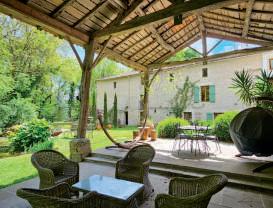






























66 etcetera listing











etcetera 67 “Big enough to cope, small enough to care” FULLY ESTABLISHED FAMILY-RUN BUSINESS Experienced overseas removals company handling Brexit customs requirements in house. We use our knowledge & expertise coupled with a friendly, flexible approach ensuring your move goes as safely, smoothly and as hassle-free as possible EUROPEAN REMOVALS UK EU EU Removals / Bradley Wills (Director) +447881370140 UK Removals / Tyler Tonkin (Director) +441736 332950 www.westcornwallremovals.co.uk Email: westcornwallremovals@gmail.com









● Wood and pellet boilers
● Air conditioning
● Solar panels
● Wood or pellet burning stoves
● Air source heat pumps
● Radiators
● Solar hot water systems
● Thermodynamic water heaters
● English speaking ● Free energy assessment of your home
● Government grants deducted directly from quotations
● Assurance Décennale, (10-year Guarantee)

Alexander Lawrence Government Approved Installer 6 allée Edmond Malinvaud, Parc d’Activités La Grande Pièce, 87280 LIMOGES Tel: 07 55 05 35 81 contact@sakkai.fr www.sakkai.fr www.sakkai.fr SAVE MONEY GO GREEN Say “Au revoir” to costly oil and gas-fired heating systems Regain Control of Your Bills and Comfort Regain Control of Your Bills and Comfort We Install:
Our Services:








































































































 ByMikeGeorge
ByMikeGeorge
































 ByEricLeClere
ByEricLeClere




















 ANGLO FRENCH HELP contact@anglofrenchhelp.com
ANGLO FRENCH HELP contact@anglofrenchhelp.com








































 ByRafaëlDupré
ByRafaëlDupré

 ByRonnieOgier
ByRonnieOgier


































 Happy Star Gazing!
Happy Star Gazing!

















 By Anne Grose
By Anne Grose




































































































































































































































